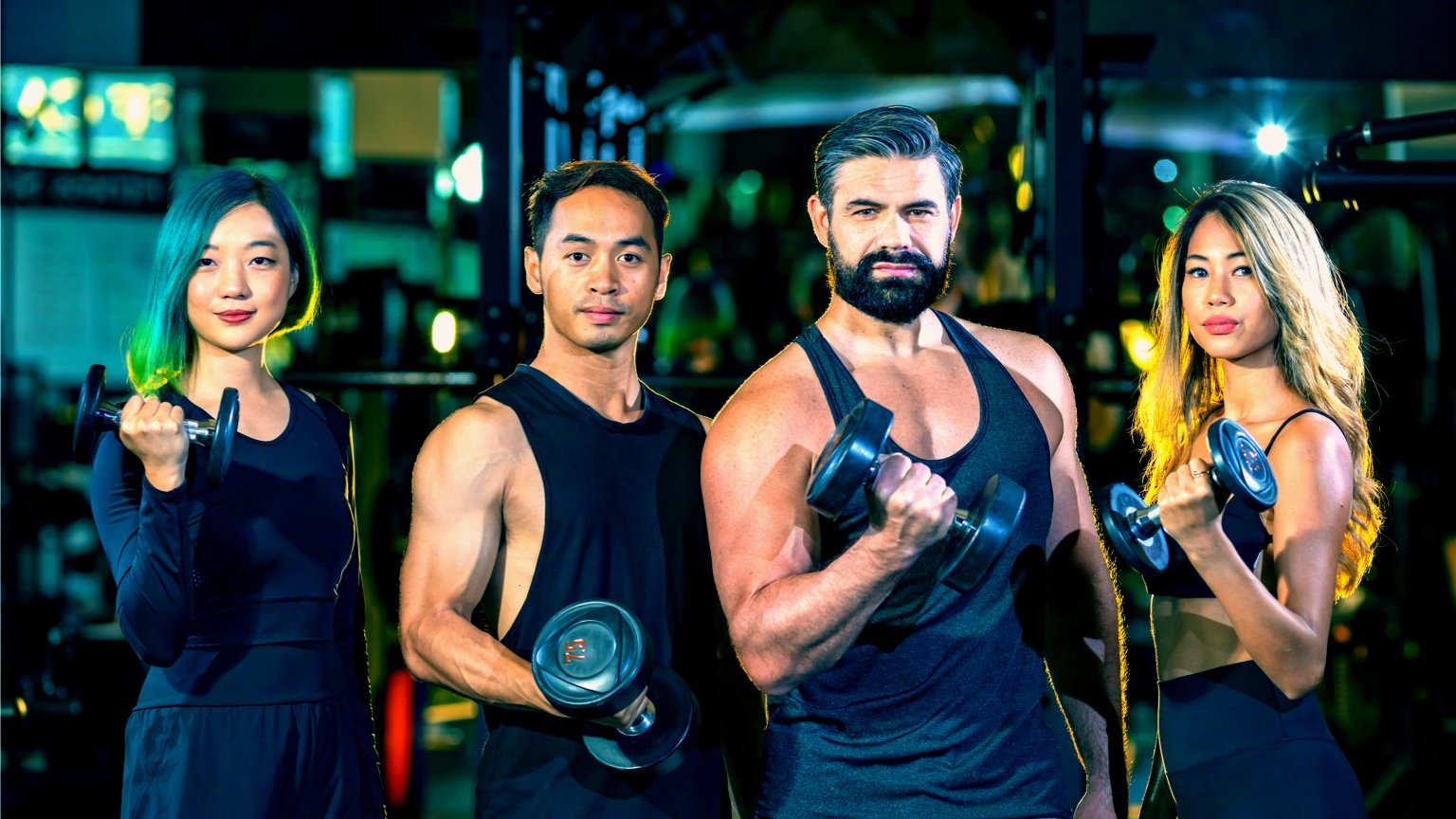Traditional bicep curls

The classic standing dumbbell bicep curl is easy to perform at home or at the gym - all you need is a set of dumbbells! The standing position engages your core moreso than seated bicep workouts. It's a great isolation exercise that strengthens your biceps muscles.
How to do
- Stand upright with a dumbbell in each hand. Your palms should be facing forwards.
- Exhale and curl the weights up towards your chest until your biceps are fully contracted.
- Squeeze your biceps at the top of the motion.
- Finally, slowly lower the weight back down to the starting position.
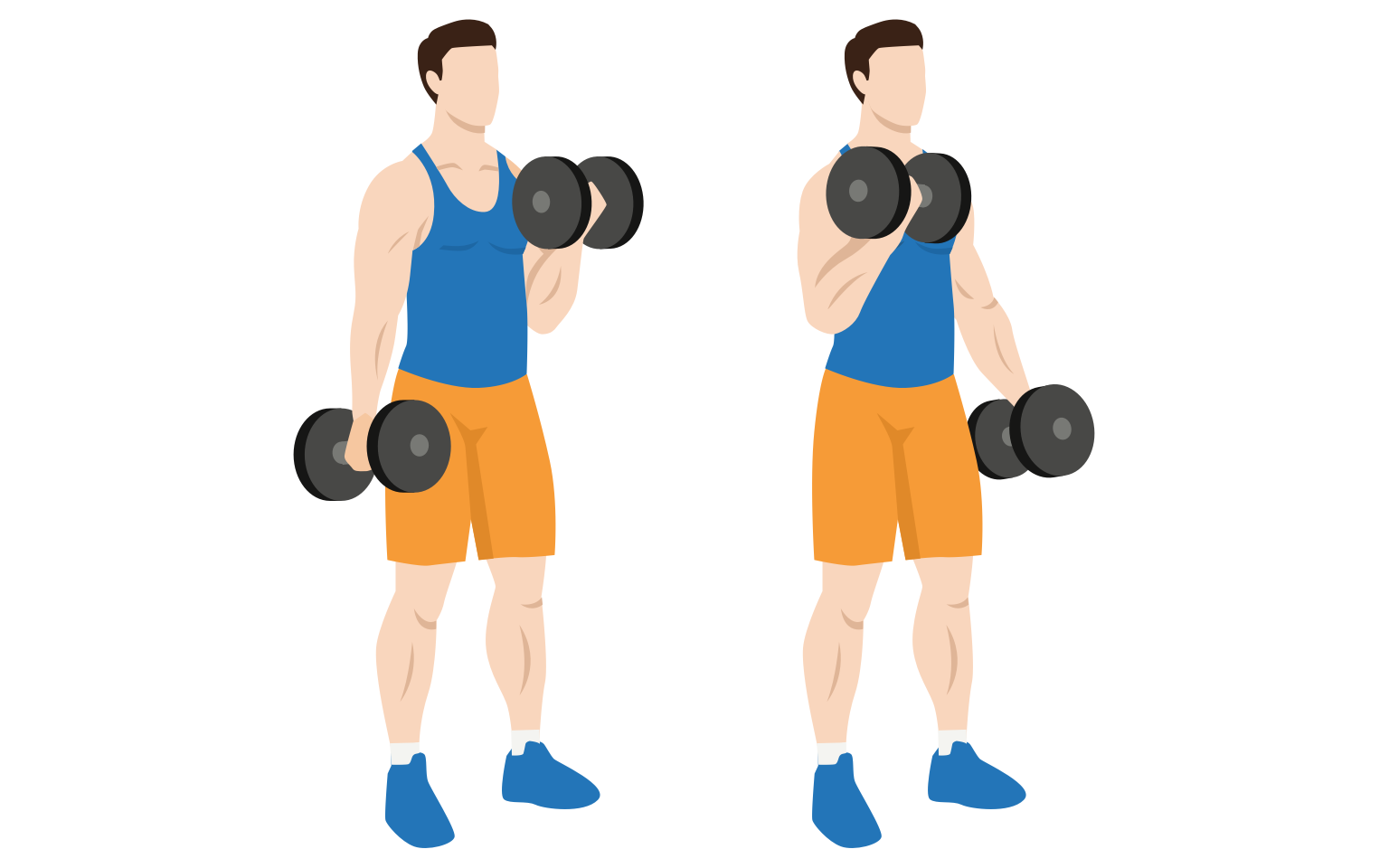
Alternating dumbbell curls are performed using each arm independently. This makes it a great exercise if you have bilateral muscular imbalance (one arm stronger than the other).
How to do
- Stand upright with a dumbbell in each hand. Your palms should be facing forwards.
- On your left side, curl the weight up towards your chest until your biceps are fully contracted.
- Squeeze your biceps at the top of the motion.
- Slowly lower the weight back down to the starting position.
- Now repeat the same exercise for your other arm.

In cross body curls, you move the weight across your chest to the opposite shoulder. Because of this motion, the exercise engages your brachialis and brachioradialis as well as your biceps muscle, making it a more comprehensive arm workout.
How to do
- Stand upright with a dumbbell in each hand.
- Extend your arms by your side with your palms facing towards your body.
- With your left arm, curl the weight up towards your right shoulder, keeping your upper arm fixed in position.
- Squeeze your bicep at the top of the motion.
- Lower with control back to the starting position.
- Repeat for your other arm.
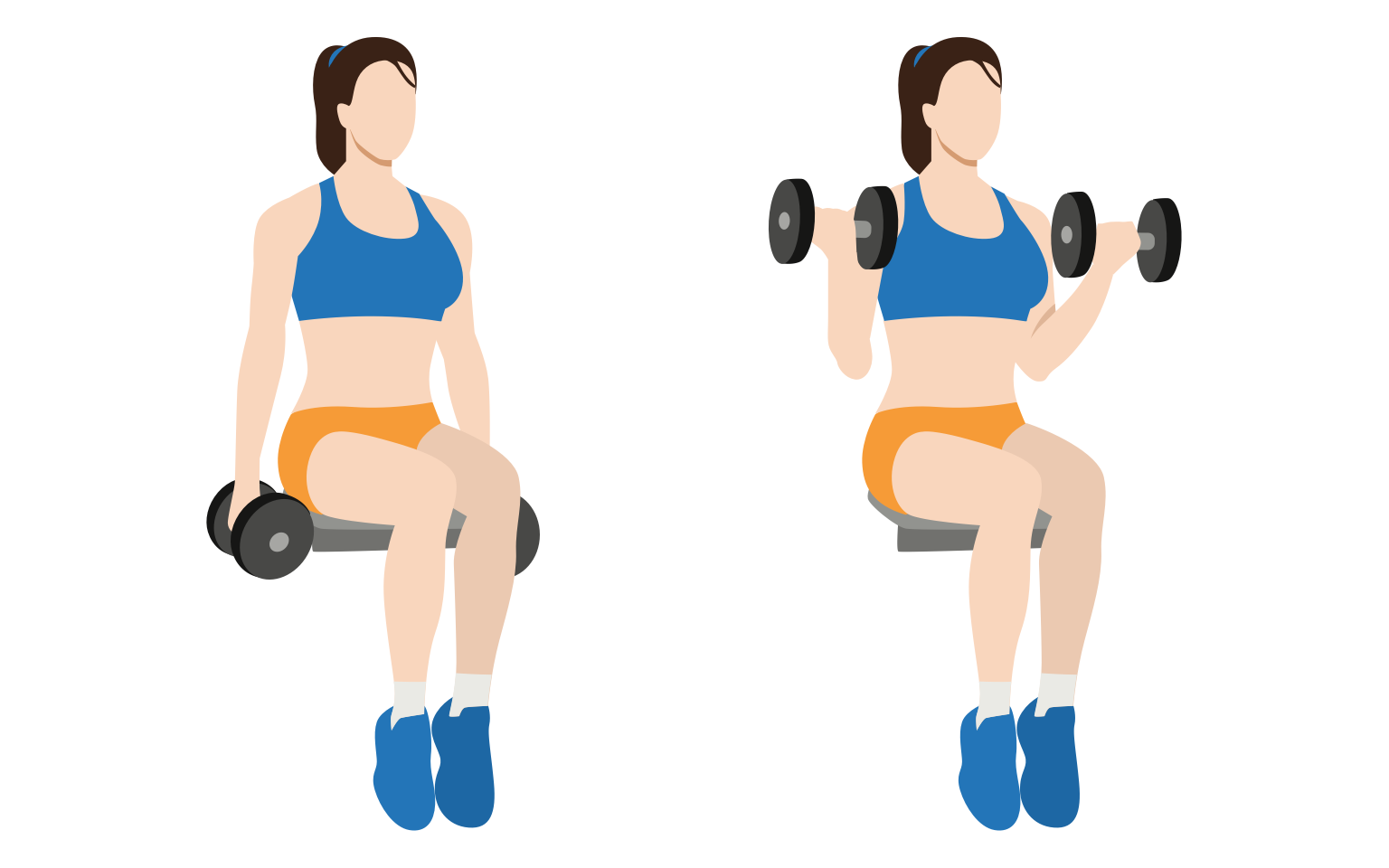
The seated variation of the bicep curl ensures your lower body is stabilized throughout the exercise. This ensures greater isolation of your biceps muscle, but will not engage your core. The seated bicep curl is a better choice if you have back pain or injuries.
How to do
- Sit on a workout bench with a dumbbell in each hand.
- Extend your arms by your side, with your palms facing towards your body.
- Exhale and curl the weights up to shoulder level.
- Squeeze your biceps at the top of the motion.
- Slowly lower back to the starting position.
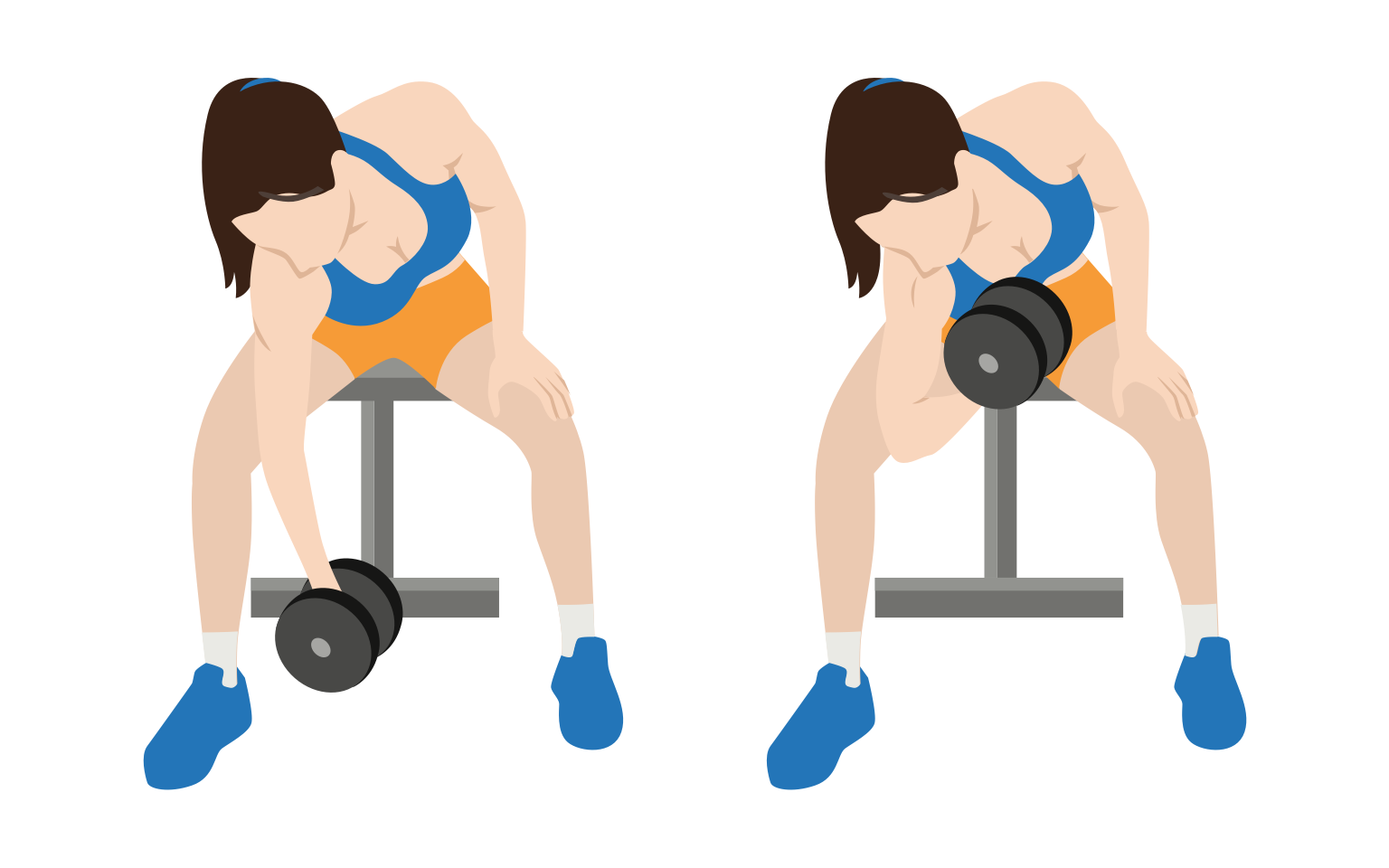
Instead of sitting upright on a bench, in concentration curls you are leaning forwards and work one arm at a time. Concentration curls emphasize the peak (long head) of your biceps. The long head is the outside part of your biceps muscle, so concentration curls are useful if your goal is to increase the size of your biceps.
How to do
- Sit at the edge of a workout bench.
- Spread your legs wide, lean forward and hold a dumbbell between them. Place your right elbow against your thigh.
- Keeping your torso stationary, contract your bicep to curl the weight up towards shoulder level.
- Squeeze your biceps at the top of the movement.
- Then slowly lower back to the starting position.
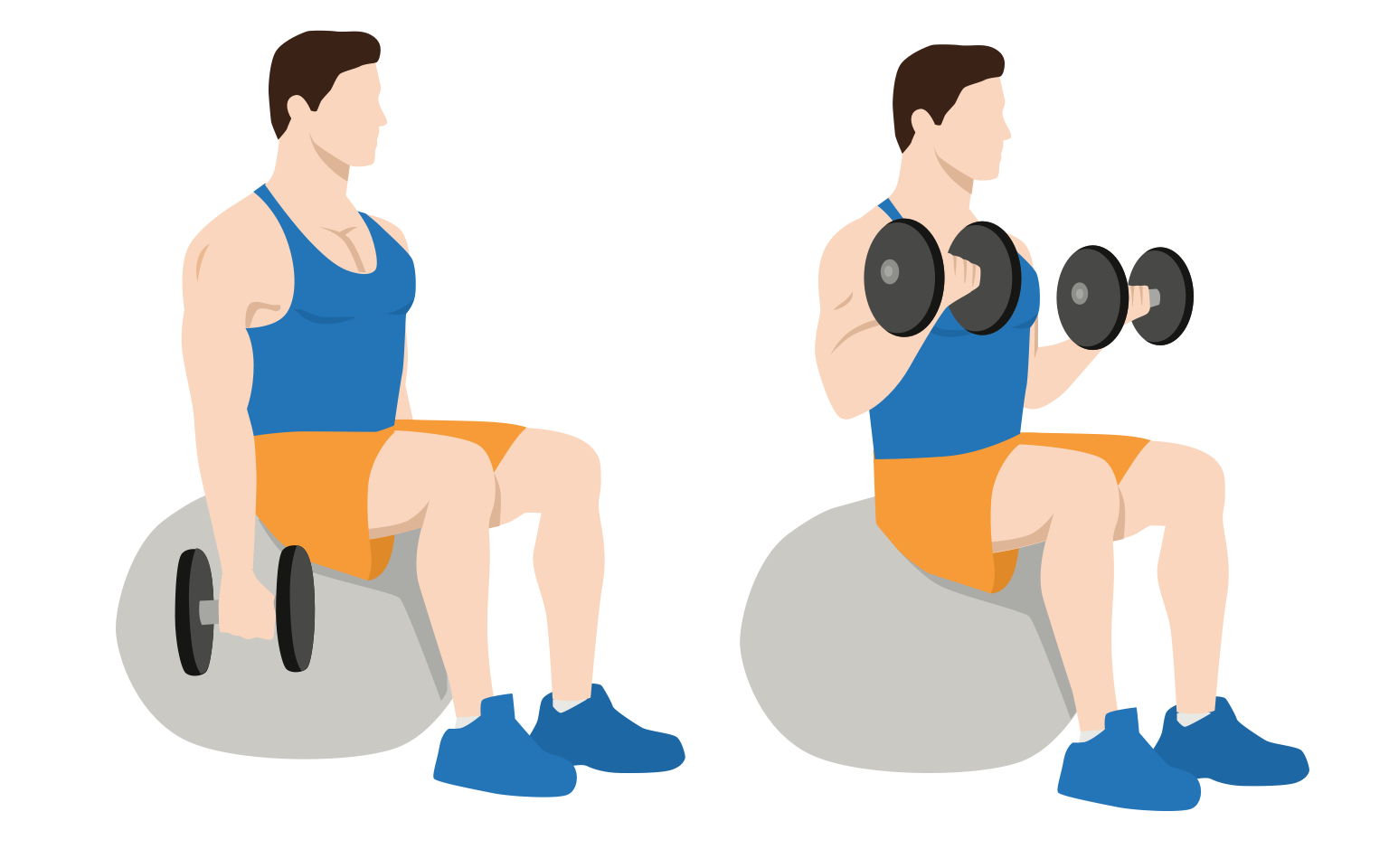
Unlike with seated bicep curls, sitting on an exercise ball engages your core and can therefore improve your balance as well as strengthening your biceps. It also hits the stabilizing muscles in your lower back, shoulders and hips. It's a great way to add variety to your regular bicep workouts.
How to do
- Sit on an exercise ball, with your feet flat on the floor.
- Let your arms hang by your sides, with a dumbbell in each hand. Your palms should be facing towards your body.
- Keeping your upper arms fixed in place, curl the weights up towards your shoulders.
- Squeeze your biceps at the top of the movement.
- Finally, slowly lower back to the starting position.
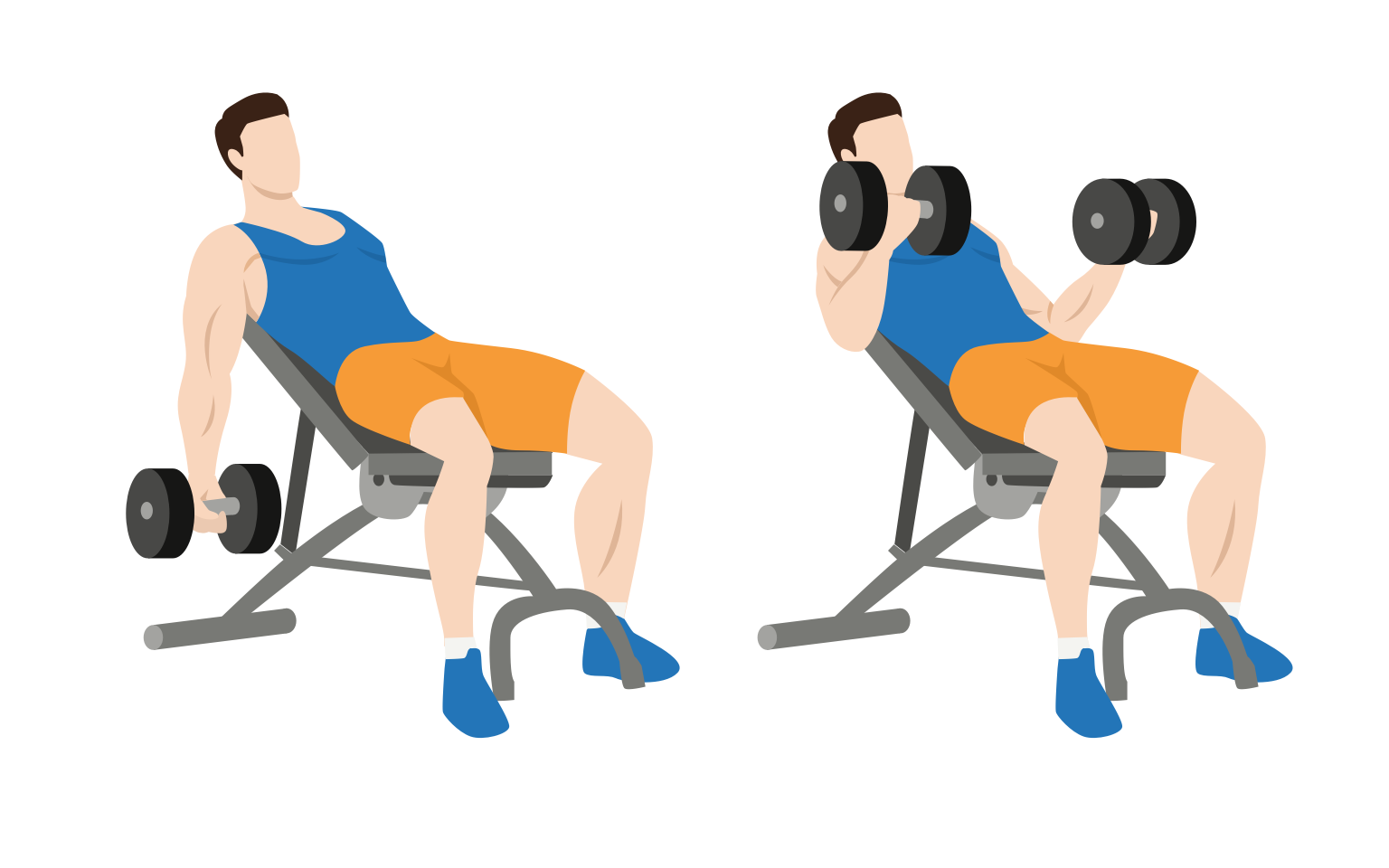
Incline dumbbell curls have a greater range of motion compared to seated bicep curls. Because your arms move behind your body, this exercise also works the long head of your biceps more than other bicep curls. This exercise is a good choice if your goal is to build bigger and more aesthetically-impressive biceps.
How to do
- Set your adjustable inline bench to an angle of 30-45 degrees.
- Sit with your back firmly against the bench and hold a dumbbell in each hand. Extend your arms with your palms facing forwards.
- Keeping your elbows close to your body, curl the weight by contracting your biceps .
- Squeeze at the top of the movement.
- Then, slowly lower the weight back to the starting position.
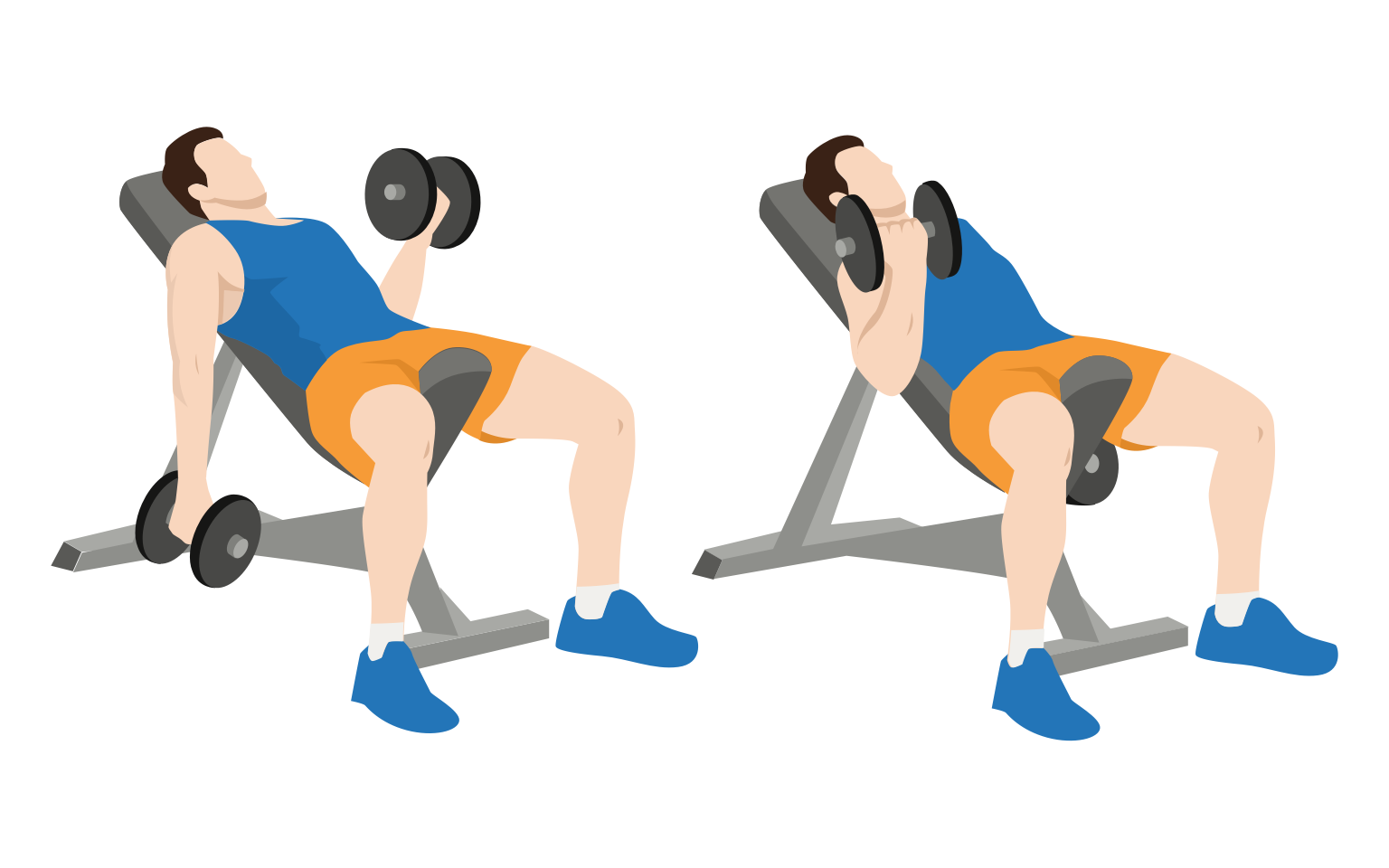
This variation of the incline dumbbell curl works one arm at a time. This makes it a great option if you have a muscular imbalance, but otherwise has all the same benefits of regular incline dumbbell curls.
How to do
- Set your adjustable inline bench to an angle of 30-45 degrees.
- Sit with your back firmly against the bench and hold a dumbbell in each hand. Extend your arms with your palms facing forwards.
- With your left arm, curl the weight by contracting your biceps.
- Squeeze at the top, then slowly lower the weight back to the starting position.
- Now repeat with your right arm.
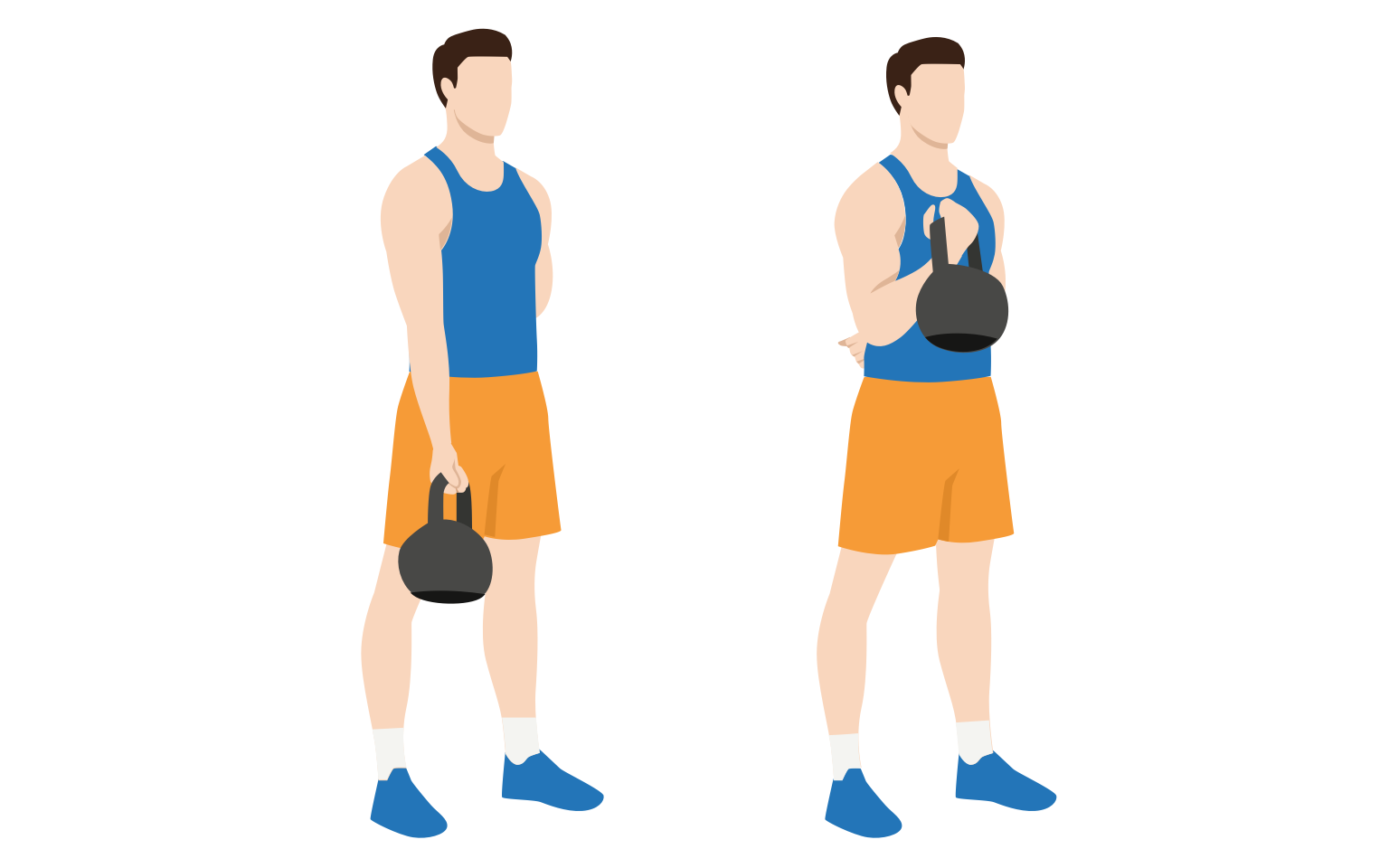
Kettlebell bicep curls can be more challenging than regular bicep workouts. This is because with dumbbell bicep curls, the weight is eventually lifted above your wrist at the top of the curl. With a kettlebell, however, the weight is always below your wrist. This type of exercise can improve your forearm and grip strength.
How to do
- Stand upright, with your feet shoulder-width apart.
- Hold a kettlebell in one hand, with your palms facing forwards.
- Keeping your upper arms fixed, curl the kettlebell up until your hand is at shoulder level.
- Squeeze your biceps at the top of the movement.
- Then, slowly lower the kettlebell back to the starting position.
Hammer curls
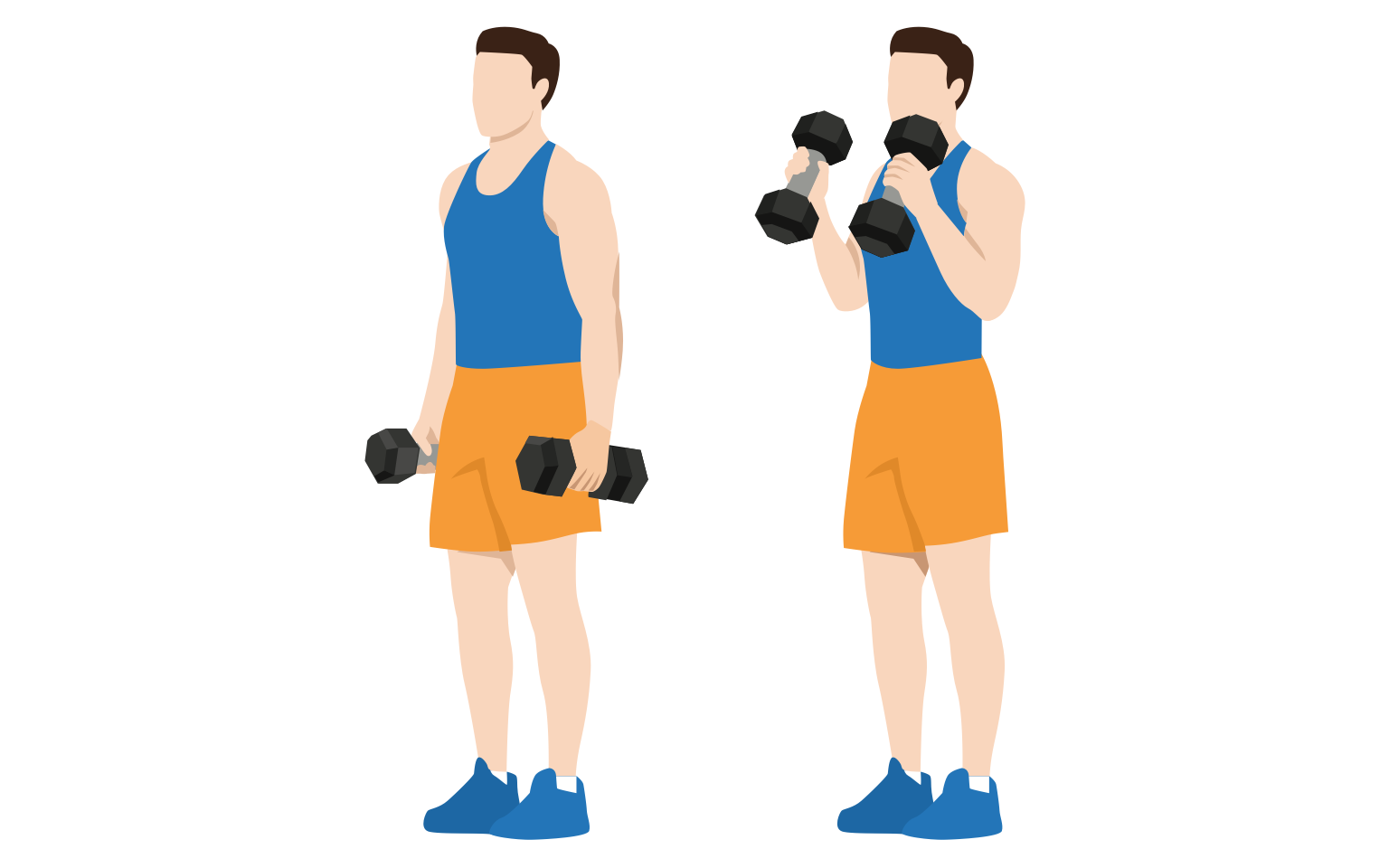
Hammer curls use a neutral grip position (palms facing each other) compared to regular bicep curls which use a supinated grip (palms facing forwards). Hammer curls are more effective in working the long head of your biceps muscles.
How to do
- Stand upright, with your arms by your side, holding a dumbbell in each hand. Your palms should be facing your body.
- Keeping your upper arms fixed, curl the weights up to your shoulders.
- Squeeze your biceps at the top of the movment.
- Finally, lower back to the starting position.
Read more: How to Do Standing Hammer Curls
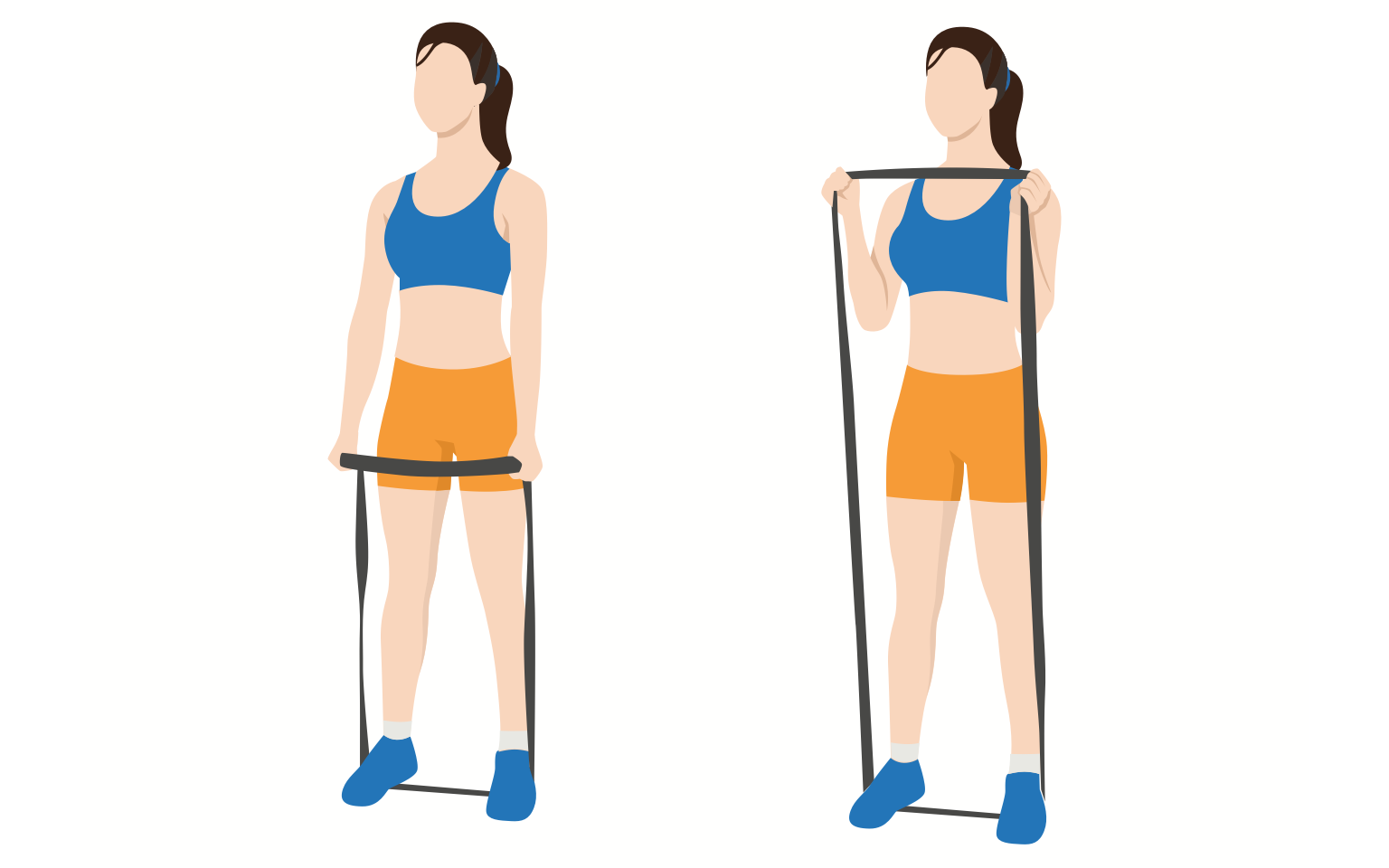
Resistance bands provide a variable resistance because the tension in the band increases as you get further into the curl. Research has shown that training with variable resistance contributes to faster development of upper and lower body strength.
How to do
- Step onto a resistance band with your feet shoulder-width apart.
- Grab the top of the resistance band with your hands in the typical hammer curl position. Use a neutral grip (palms facing towards your body).
- With your upper arms fixed in place, curl up towards your shoulders.
- Squeeze your biceps at the top.
- Lower back to the starting position, maintaining tension in the band at all times.

The lunging hammer curl is a compound exercise that can build strength in your lower body, while at the same time working your biceps. You can use this exercise to improve your overall balance and coordination.
How to do
- Stand upright with a dumbbell in each hand, using a neutral grip.
- With your right leg forwards, step into the lunge position so that your knees are at a 90 degree angle. Your right knee should be inline with your toes.
- As you descend into the lunge, perform a hammer curl by lifting the dumbbells towards your shoulders.
- Reverse the lunge, lowering the dumbbells back to the starting position.
- Repeat by lunging with your left leg.
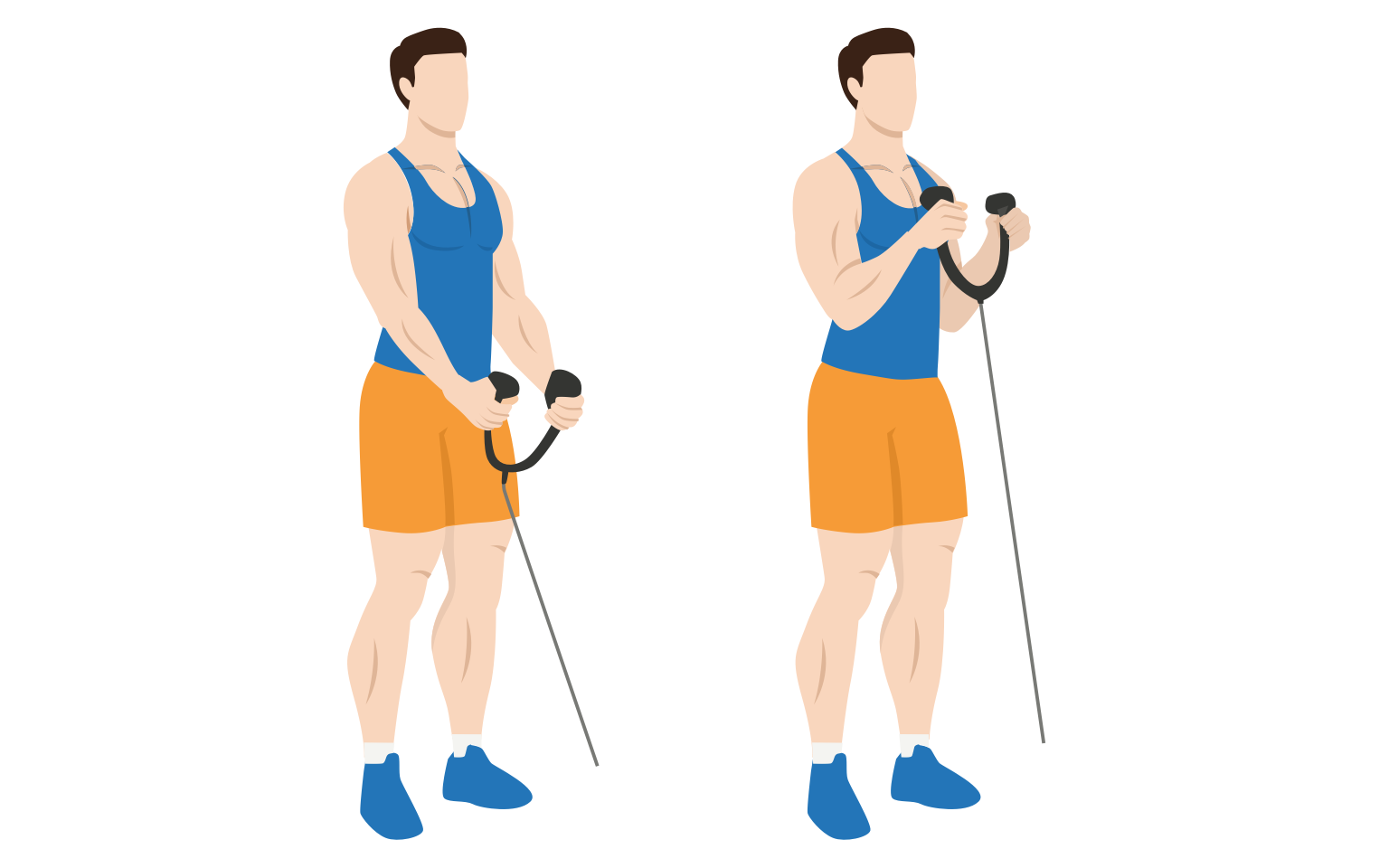
The cable machine provides a constant tension, whereas dumbbells provide a varying resistance throughout the range of motion. A constant tension allows you to lift a heavier weight than would be possible with free weights, which can help you progress quicker to bigger and stronger biceps.
How to do
- Attach a rope handle to the low pulley.
- Stand facing the machine, with your feet shoulder-width apart and grab the rope with a neutral grip (palms facing each other).
- Keeping your upper arms fixed in position, curl up towards your shoulders.
- Squeeze at the top of the movement.
- Then, slowly lower back to the starting position.
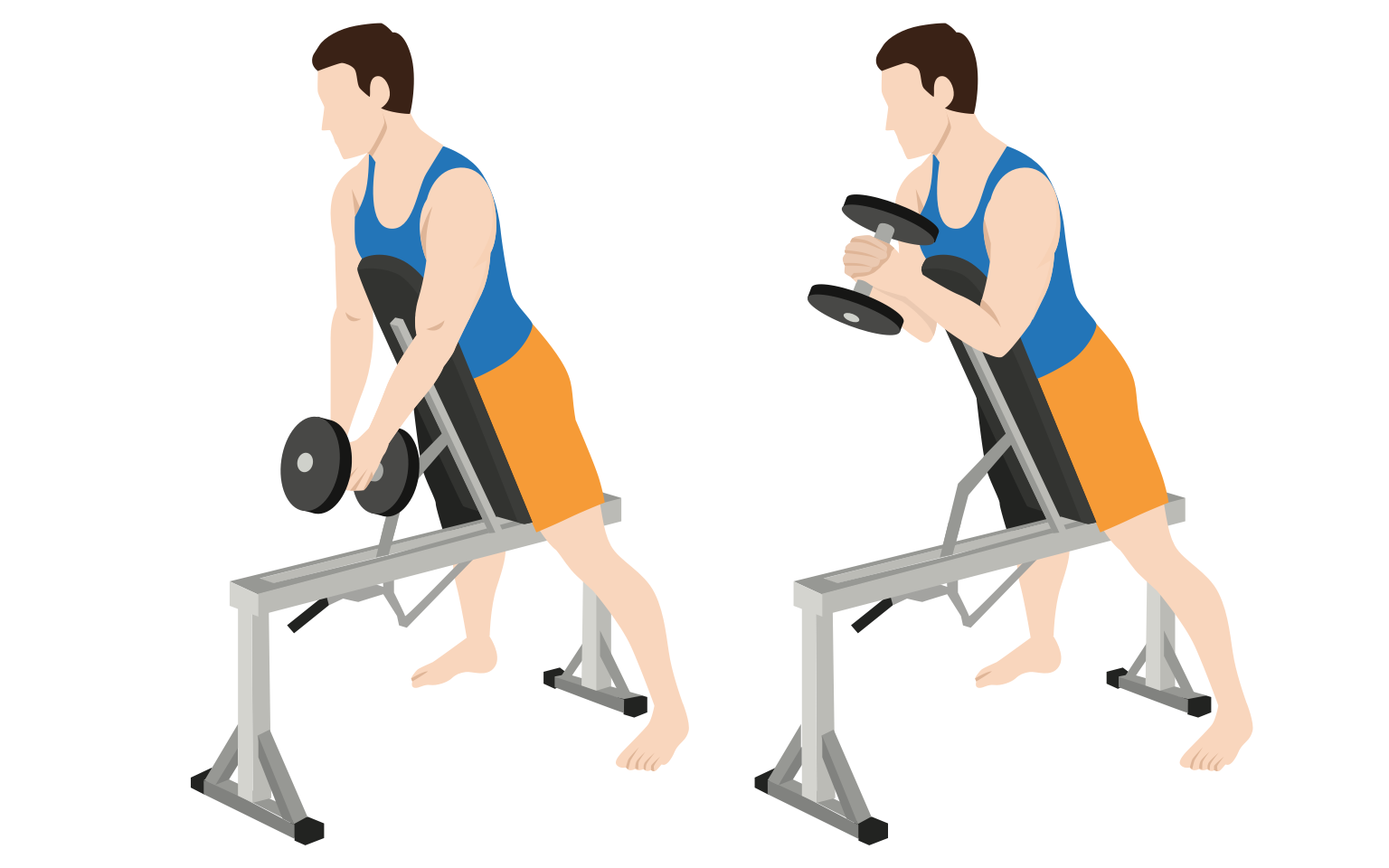
Spider curls are performed on an incline bench, further isolating the biceps compared to standing hammer curls. This variation emphasizes the short head of your biceps muscle because of the hanging position of your arms. And because the bench supports your bodyweight, there is less chance of using momentum to assist in the exercise.
How to do
- Set an incline bench to 60 degrees.
- Lean with your chest against the pad, holding one dumbbell with two hands.
- Curl the dumbbell up towards your chest.
- Squeeze your biceps at the top of the movement.
- Finally, lower back to the starting position.
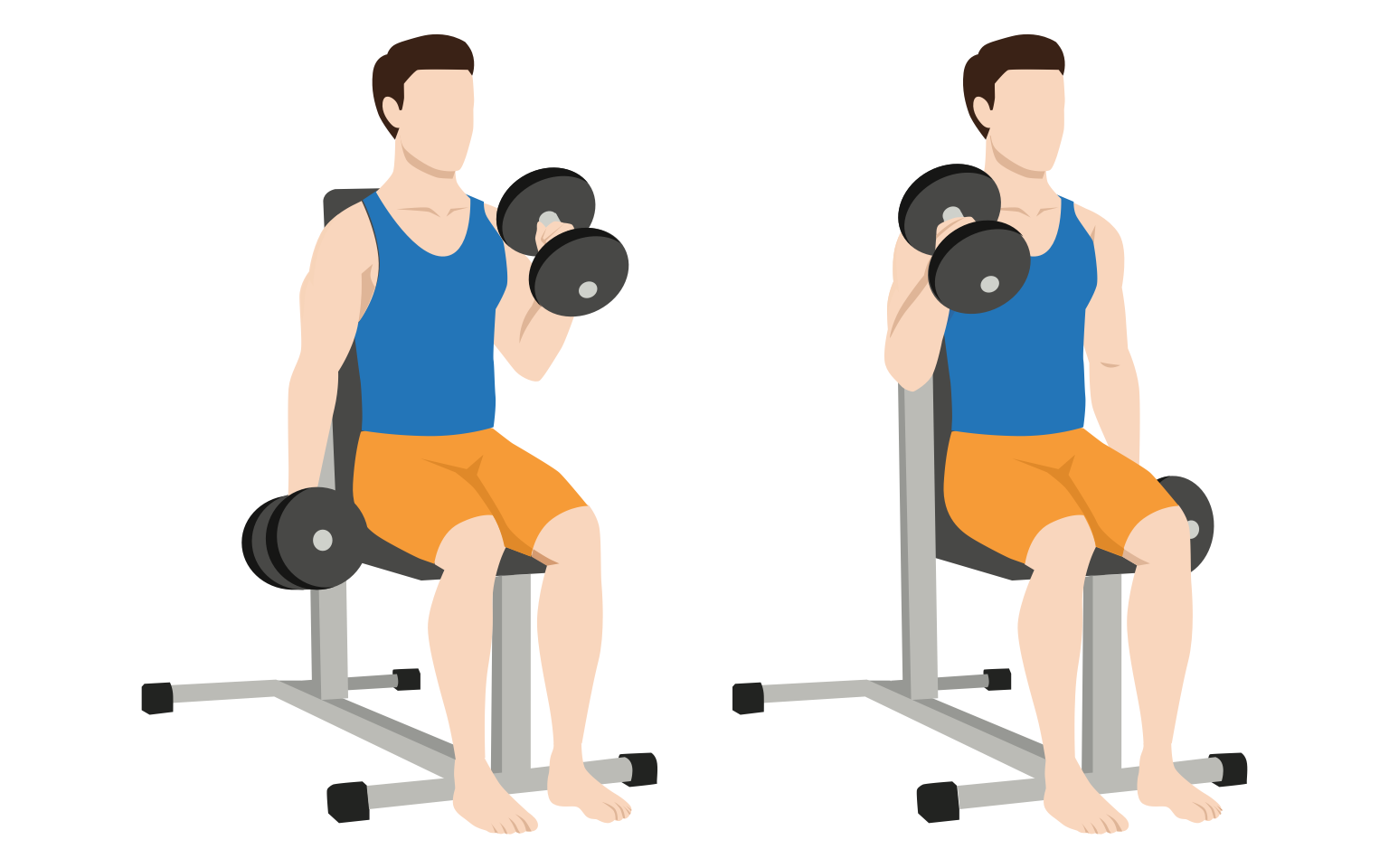
The seated position stabilizes your upper focus, allowing you to focus more on working your biceps muscles. It's important to note that this variation will not engage your core.
How to do
- Sit on a bench with your arms by your sides.
- Hold a dumbbell in each hand with a neutral grip.
- Curl up with your left arm, keeping your upper arm stationary.
- Squeeze at the top, then lower back to the starting position.
- Repeat the exercise with your right arm.
Read more: How to Do Seated Hammer Curls
Preacher curls

By using a preacher curl bench, the preacher hammer curl stabilizes your upper arm by keeping your elbow fixed against the pad during the movement. Because your upper arms are positioned slightly forwards, this provides a different type of tension compared to standing or seated bicep workouts.
How to do
- With your arm rested on the preacher curl pad, hold a dumbbell with a neutral grip.
- Curl the weight up until your bicep is fully contracted.
- Squeeze at the top of the movement.
- Then, lower back down to the starting position.
Read more: How to Do Preacher Hammer Curls
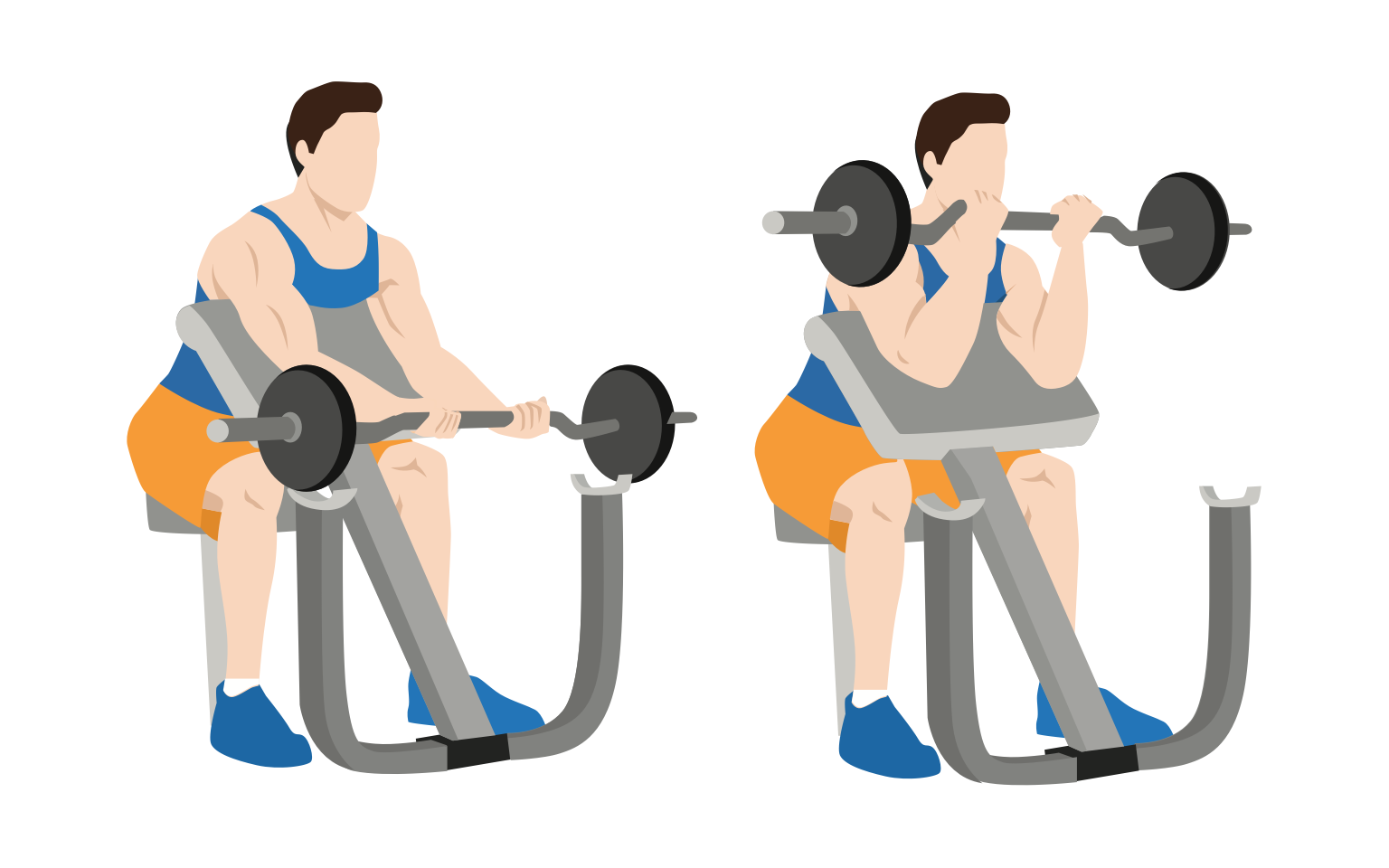
The EZ bar has a unique shape that allows for a more natural grip compared with a barbell. Performed using a preacher curl bench, this is an effective exercise for isolating your biceps. The bench prevents the use of momentum to assist in the curl.
How to do
- With your upper arms rested against the preacher bench pad, pick up the EZ bar with an underhand grip. Your hands should be shoulder-width apart.
- Curl the bar upwards in a smooth motion.
- Squeeze at the top of the movement.
- Then, lower the bar slowly back to the starting position.
Read more: How to Do EZ Bar Preacher Curls

The regular bicep curl is a popular exercise with many first-time gym-goers. One common mistake with the bicep curl is using momentum or 'swinging your arms' to assist in the movement. Preacher curls prevent this because your arm remains fixed on the preacher bench pad throughout the exercise.
How to do
- Hold a dumbbell in one hand with your palm facing upwards. Rest your upper arm against the preacher bench pad.
- Curl the dumbbell up towards your shoulder.
- Squeeze at the top of the movement.
- Then, lower back to the starting position in a slow, controlled motion.
Read more: How to Do Single Arm Preacher Curls
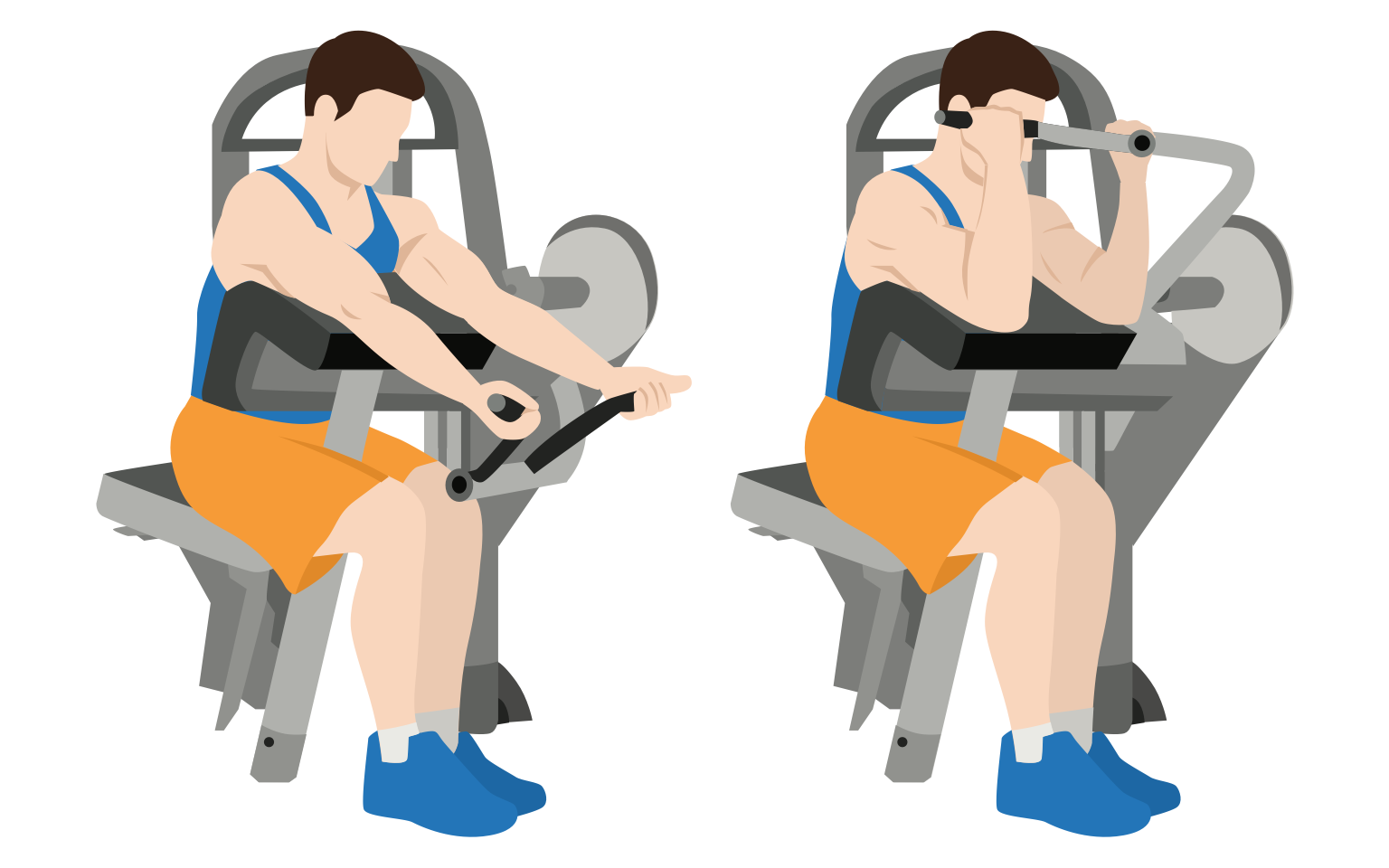
The preacher curl machine provides a constant tension through the range of motion, allowing for a stable and controlled motion. This makes it a great choice for beginners. The constant tension also reduces the risk of injury compared with free weight bicep workouts, such as the preacher curl.
How to do
- Adjust the machine to select the appropriate resistance.
- Place your upper arms on the pad and grab the handles with your palms facing up.
- Pull the handles towards your shoulders to start the curl.
- Squeeze your biceps at the top of the motion.
- Then, lower back to the starting position in a slow and controlled motion.
Read more: How to Do Machine Preacher Curls
Cable machine curls
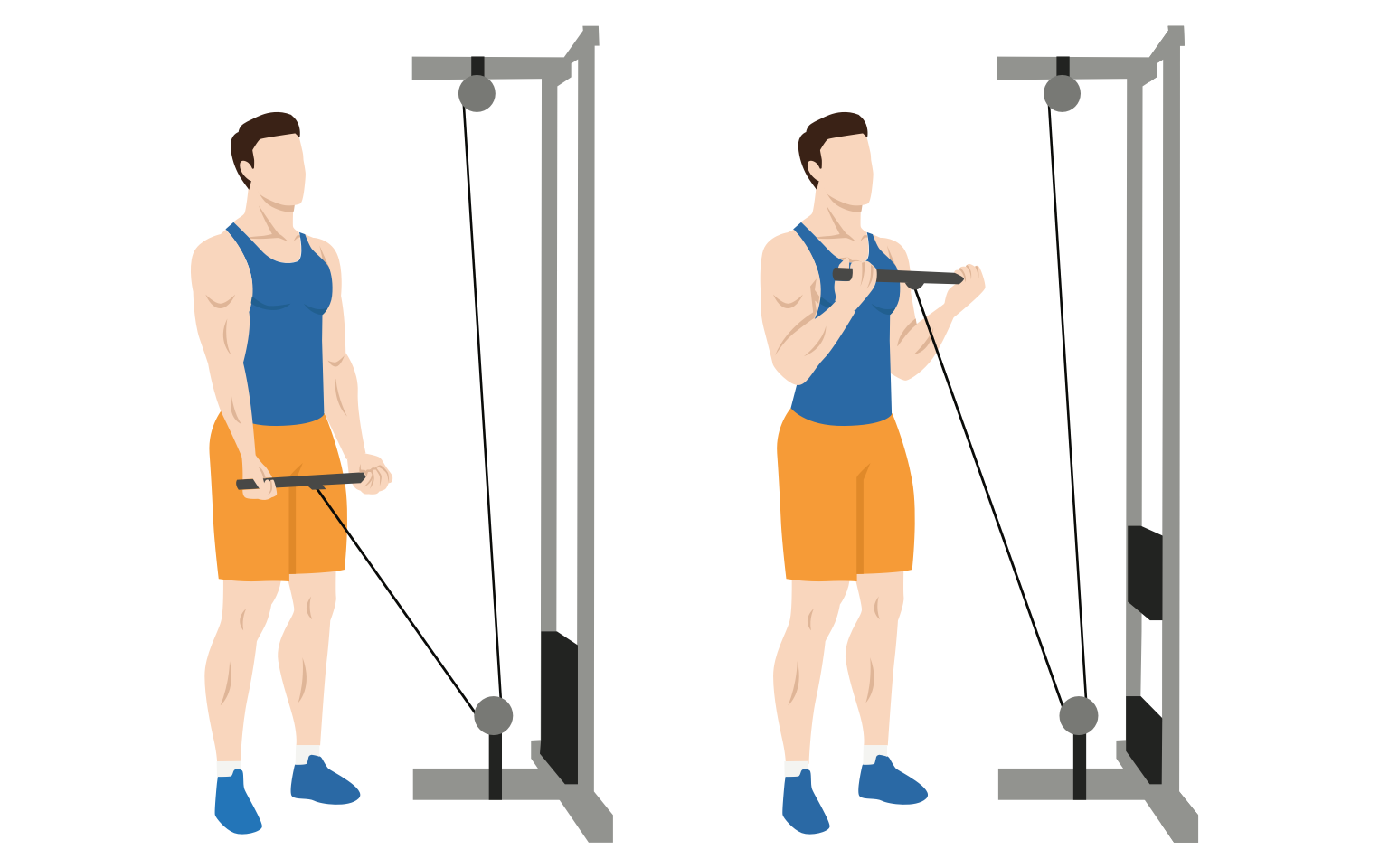
Using a cable machine provides a constant tension throughout the range of motion of each curl. Smoother and controlled tension reduces the risk of injury, and also allows you to lift a higher weight than would be possible with free weight bicep workouts.
How to do
- Attach the straight bar to the low pulley.
- Stand facing the machine, with your feet shoulder-width apart. Grab the bar with an underhand grip.
- Keeping your upper arms stationary, curl the bar up towards your chest.
- Squeeze your biceps at the top of the motion.
- Then, lower back to the starting position.
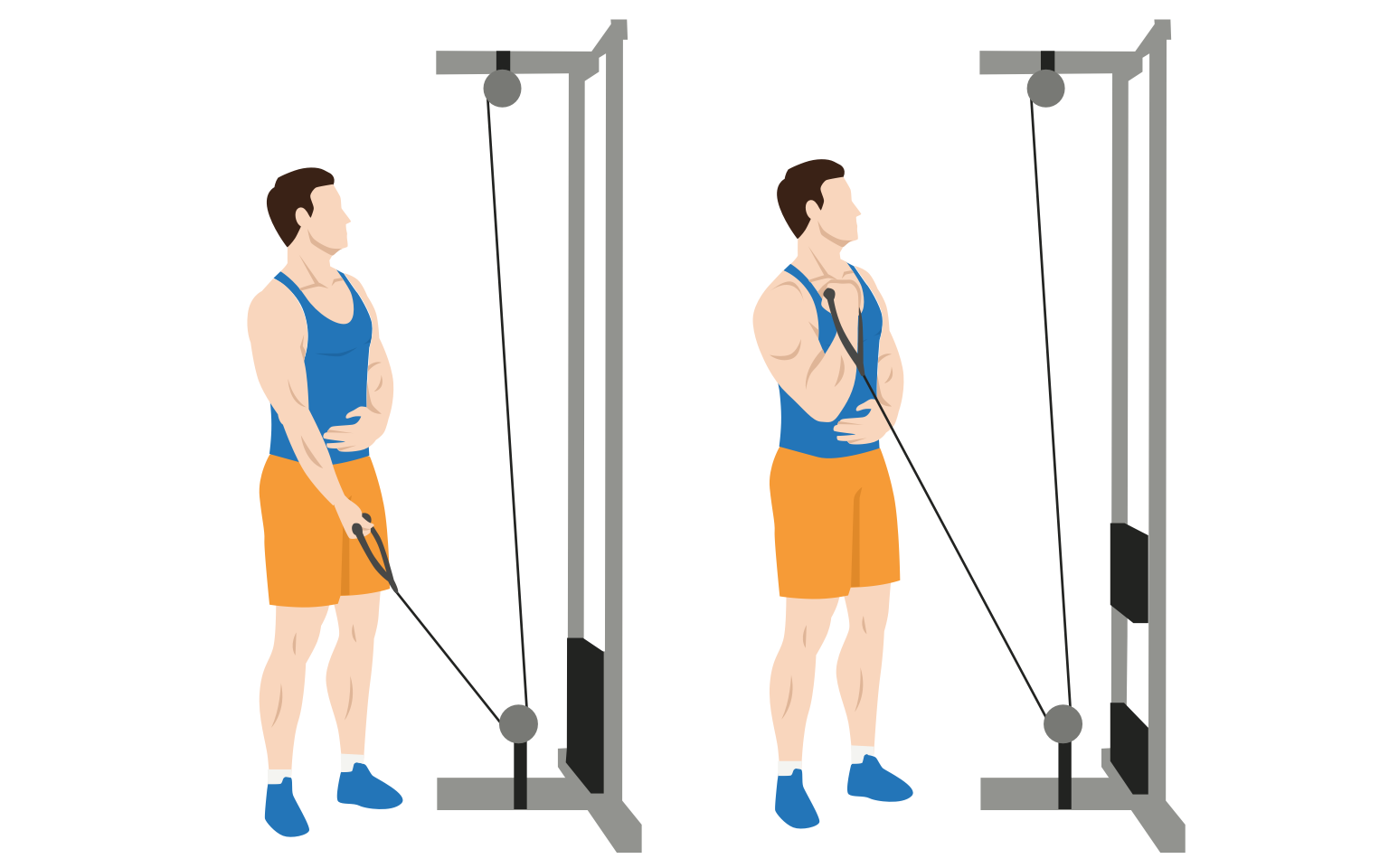
This variation of the cable curl works one arm at a time. This makes it a great choice if you need to address a bilateral strength imbalance.
How to do
- Attach the D-handle to the low pulley.
- Stand facing the cable curl machine at a slight angle, if you prefer.
- With your upper arms stationary, curl the handle up towards your shoulder.
- Squeeze your bicep at the top of the motion.
- Then, slowly lower back to the starting position.

The reverse cable curl is similar to the cable curl, except you use an overhand grip rather than an underhand grip. This change in grip puts more emphasis on your brachialis and brachioradialis.
How to do
- Attach the D-handle to the low pulley.
- Grab the handle with an overhand grip (palm facing down). Stand straight with your feet shoulder-width apart.
- Keeping your upper arms stationary, curl the handle up towards your shoulder.
- Squeeze at the top of the movement.
- Then, slowly lower back to the starting position.

The overhead cable curl emphasizes the short head of your biceps, whereas the low pulley cable curl emphasizes the long head.
How to do
- Attach handles to the high pulleys of the cable system.
- Stand in the middle, holding each handle with an underhand grip (palms facing your body). Your feet should be shoulder-width apart.
- Curl towards your forehead, keeping your upper arms and elbows fixed in position.
- Squeeze at the top of the movement.
- Then, slowly return to the starting position.
Barbell curls

Because the barbell is lifted by both arms at the same time, it is often possible to lift a higher weight than would be possible with dumbbells.
How to do
- Stand upright, holding a barbell with your hands shoulder-width apart on the bar. Use an underhand grip, so your palms are facing forwards.
- With your upper arms stationary, curl the bar up towards your shoulders.
- Squeeze your biceps at the top of the motion.
- Then, slowly lower the bar back to the starting position.
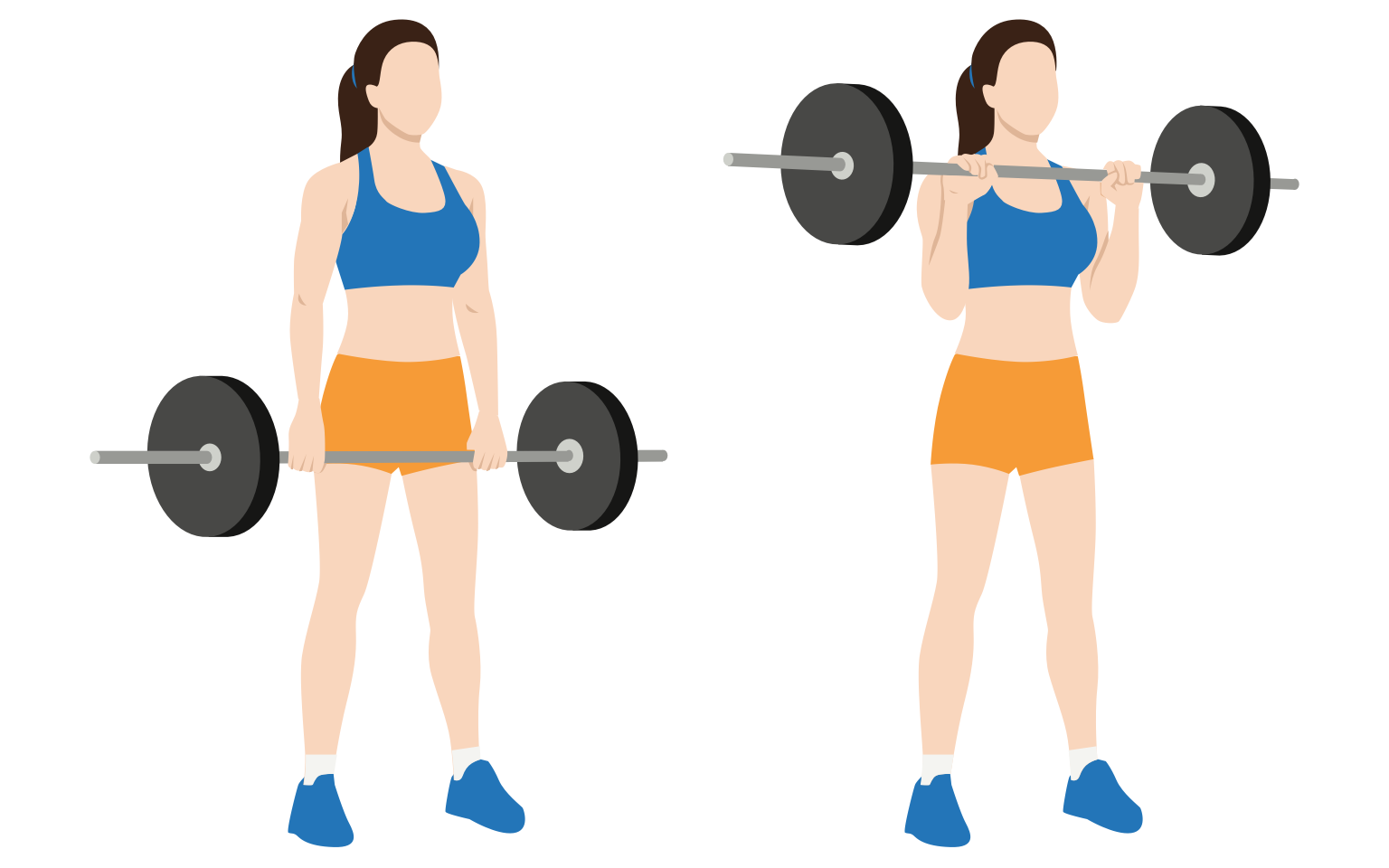
In this variation, you hold the barbell with an overhand grip (palms facing down). This places more emphasis on your brachialis and brachioradialis muscles, so it's a great exercise if you want to work your forearms in addition to your biceps.
How to do
- Stand upright with your feet shoulder-width apart.
- Hold the barbell with an overhand grip.
- With your upper arms stationary, curl the bar up towards your shoulders.
- Squeeze your biceps at the top of the movement.
- Then, lower the barbell back to the starting position.
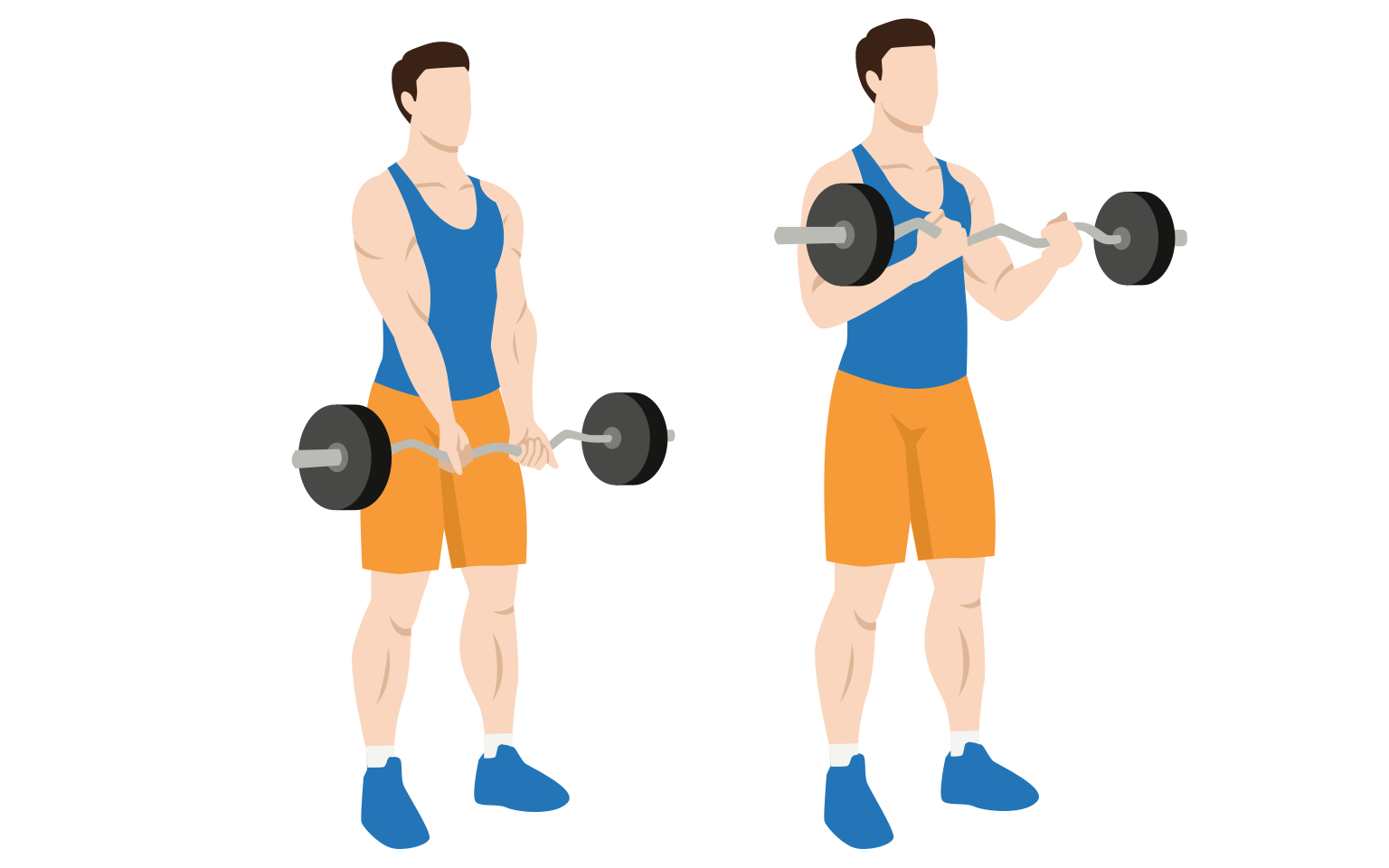
The standing EZ bar curl is more difficult than the EZ bar preacher curl, because it requires engagement of your core. It's also more challenging because, with free weight bicep workouts, you have to pay close attention to control and smooth movement.
How to do
- Stand upright with your feet shoulder-width apart.
- Hold the EZ bar at hip level, with an underhand grip (palms facing away from your body).
- With your upper arms stationary, curl the EZ bar up towards your chest.
- Squeeze your biceps at the top of the movement.
- Then, slowly lower the bar back to the starting position.
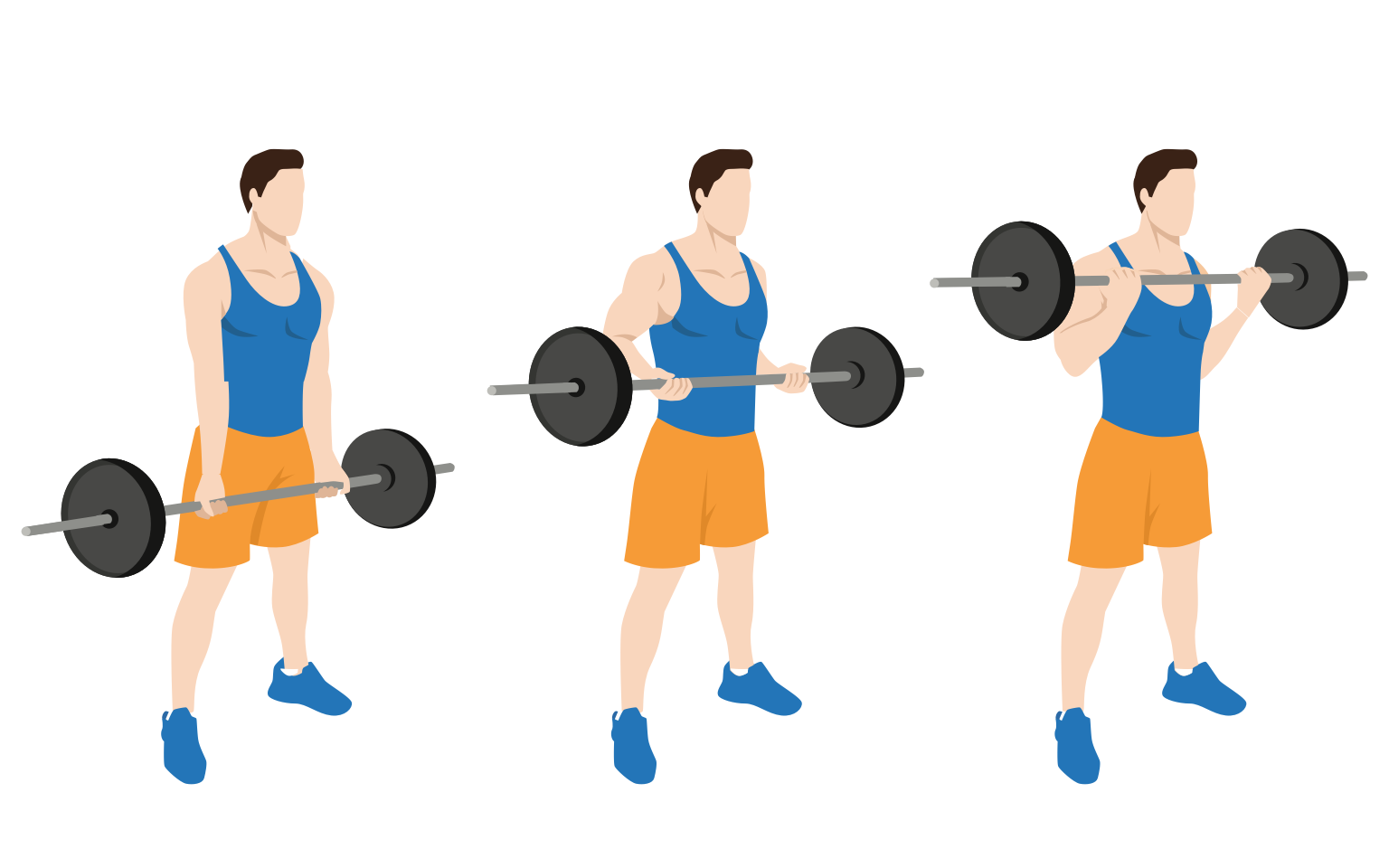
Drag curls keep the barbell close to your body throughout the entire range of motion. This shifts the focus on the exercise to your brachialis and your outer biceps.
How to do
- Stand straight, holding a barbell with an underhand grip.
- Rather than curling the bar up, instead drag it along the front of your body, moving your elbows back as necessary.
- Lift the barbell as high as possible. Squeeze your biceps at the top.
- Then, lower back to the starting position. Ensure you keep the bar close to your body on both the upward and downward movements.
Other bicep exercises
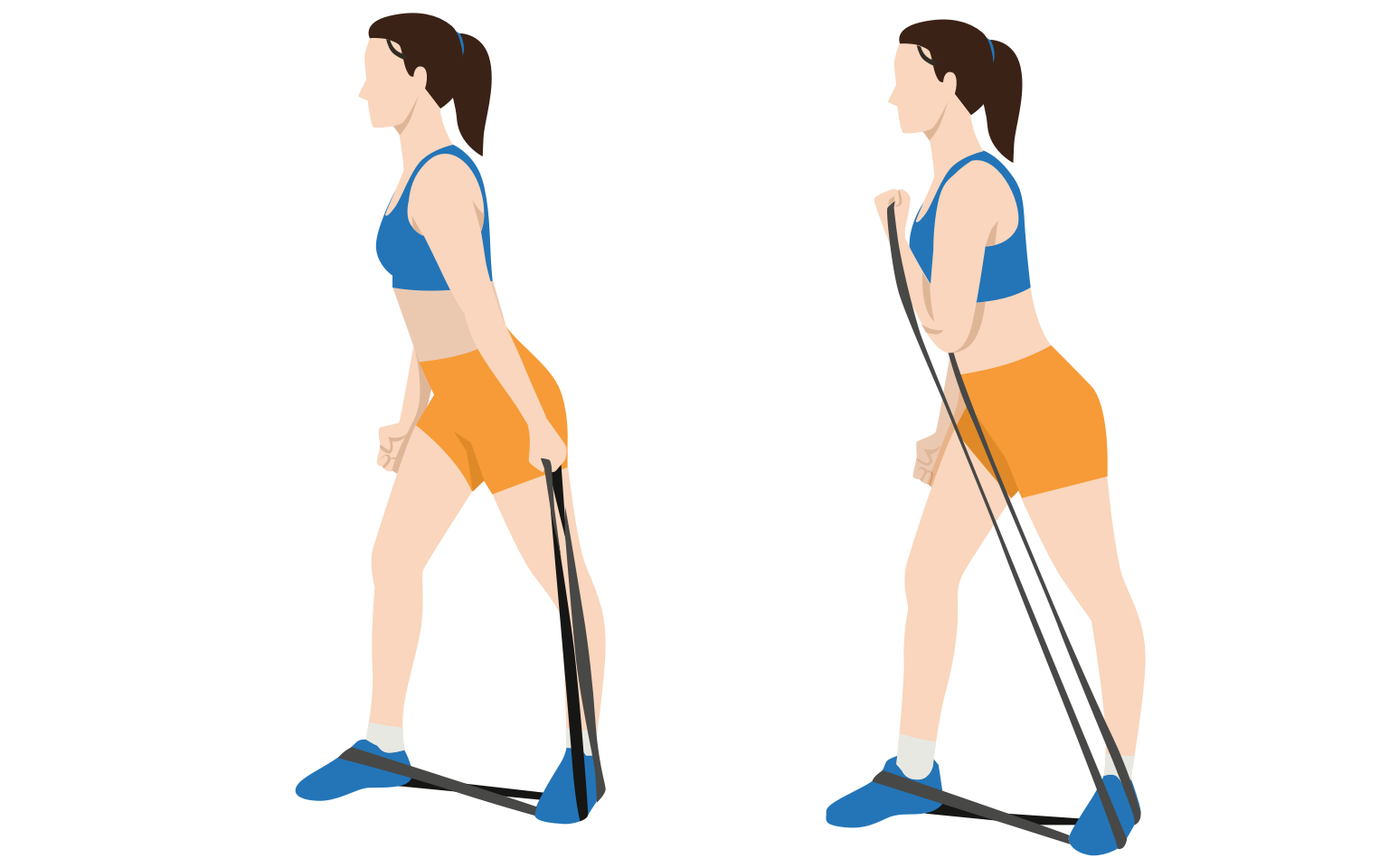
Similar to resistance band hammer curls, this exercise provides a variable resistance because the tension in the band increases as you get further into the curl. This version of the exercise is closer to a traditional bicep curl and works one arm at a time.
How to do
- Stand on a twisted resistance band, with your feet offset and positioned slightly more than shoulder-width apart.
- Lean forwards slightly, while holding the band with one hand. Use an underhand grip.
- Now, bend your arm at the elbow and curl up towards your shoulder.
- Squeeze, then lower the band back to the starting position, while maintaining tension in the band.
- Repeat with your other arm.

The TRX bicep curl is a more challenging exercise because of the instability of the straps, as well as your posture during the exercise. This variation is great for building stronger biceps, along with improving your balance and stability.
How to do
- Hold the TRX handles with an underhand grip (palms facing up).
- Stand facing the anchor point and lean back slightly with your arms extended.
- Pull your body towards the handles by bending your elbows, bringing your face close to the handles.
- Squeeze at the top, then lower back to the starting position.
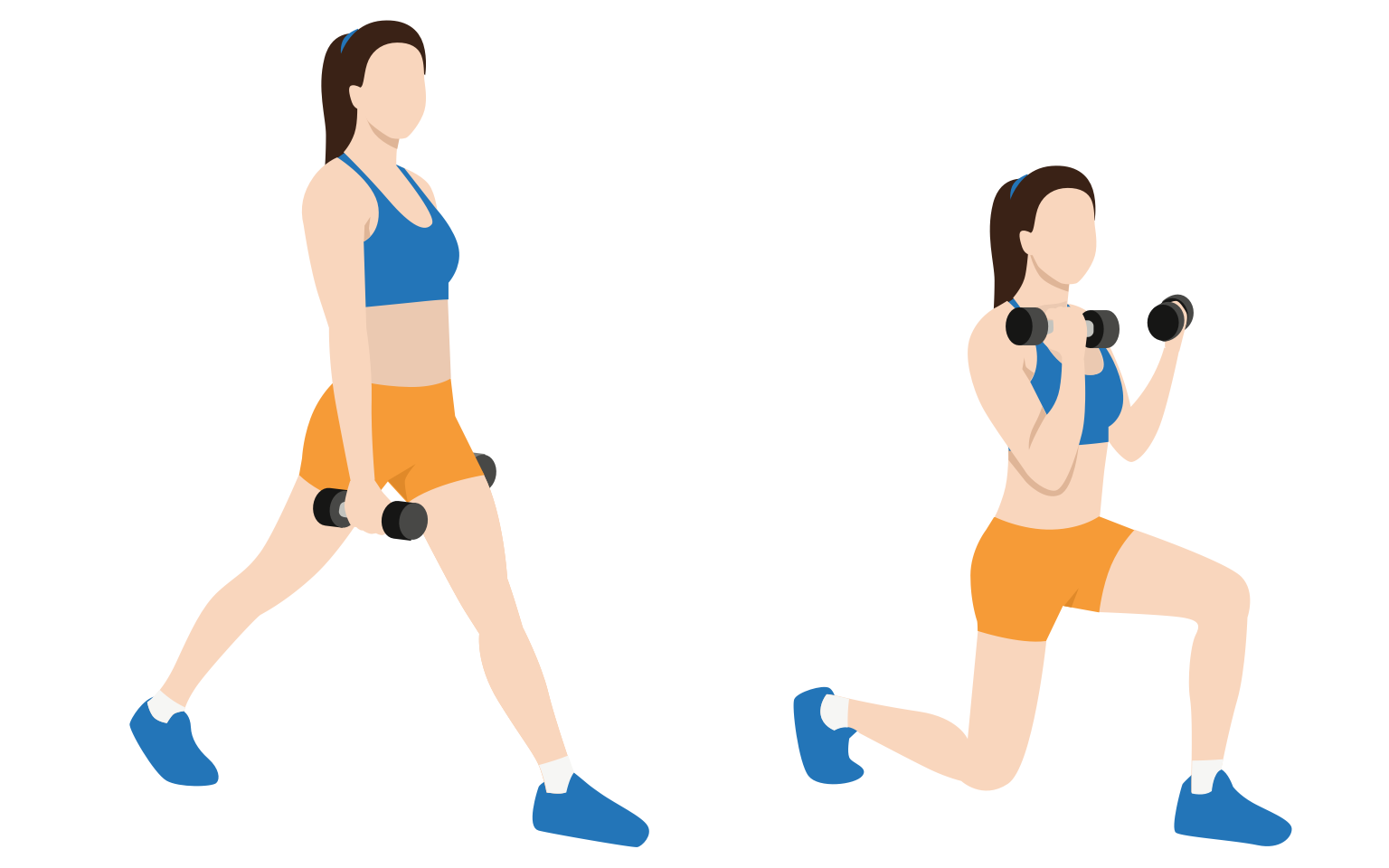
Split squat curls are a compound exercise that can build strength in your lower body, while at the same time working your biceps. You can use this exercise to improve your overall balance and coordination. This exercise is similar to lunging hammer curls.
How to do
- Stand upright with a dumbbell in each hand, using an underhand grip (palms facing your body).
- With your right leg forwards, step into the lunge position so that your knees are at a 90 degree angle. Your right knee should be inline with your toes.
- As you descend into the lunge, perform a bicep curl by lifting the dumbbells towards your shoulders.
- Reverse the lunge, lowering the dumbbells back to the starting position.
- Repeat by lunging with your left leg.
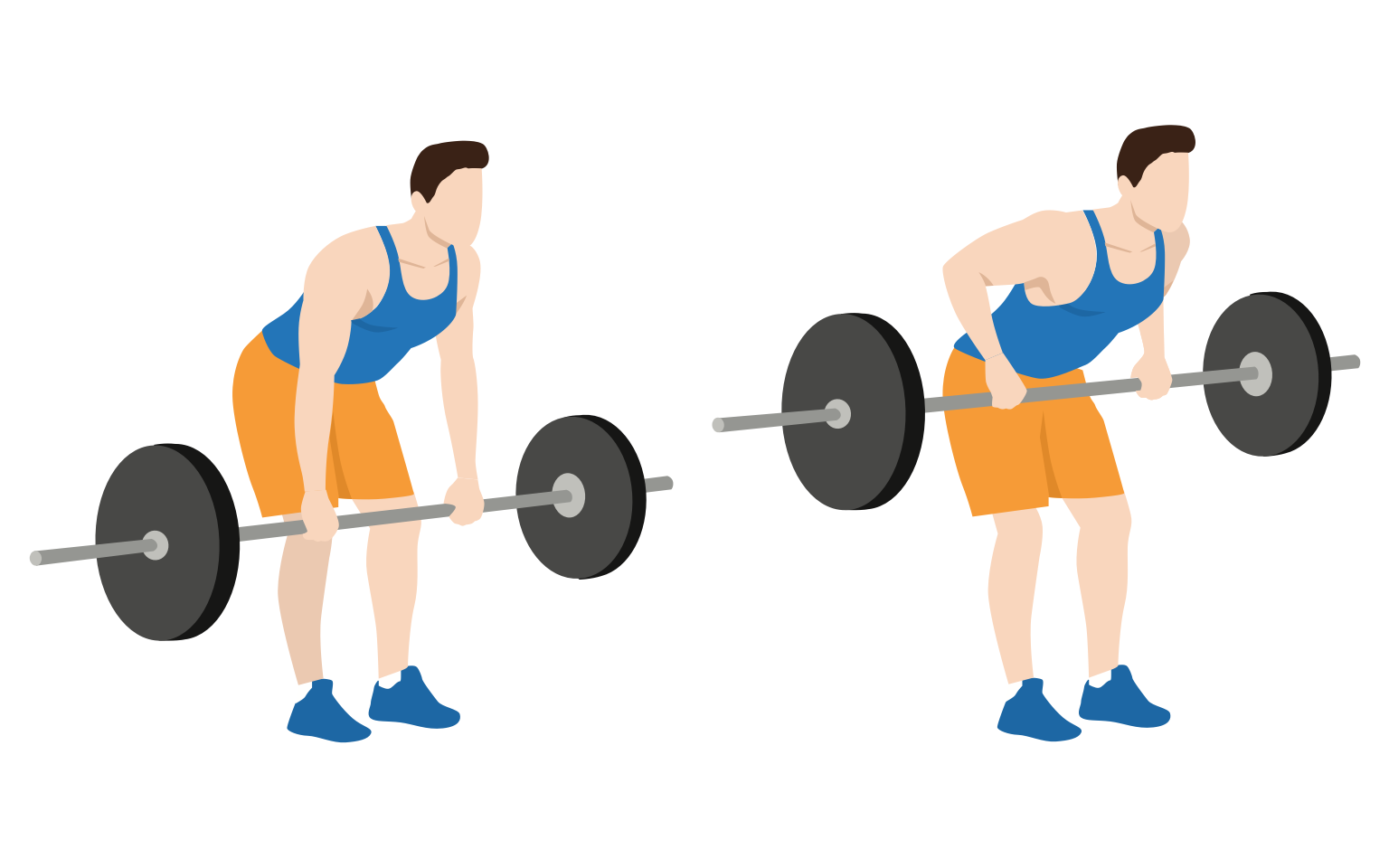
The barbell bent over row is a great exercise for working your back, shoulders and arms. This exercise targets your back muscles more, and biceps muscles less, than bicep isolation exercises like the bicep curl. It is, however, a good compound exercise that works your biceps and can contribute to their development.
How to do
- Stand with your feet hip-width apart, holding a barbell with an overhand grip.
- Bend at your waist, keeping your back straight.
- Pull the weight up towards your chest, keeping your elbows close to your body.
- Then lower the weight back to the starting position. Keep your core engaged throughout the movement.
Read more: How to Do Bent Over Rows
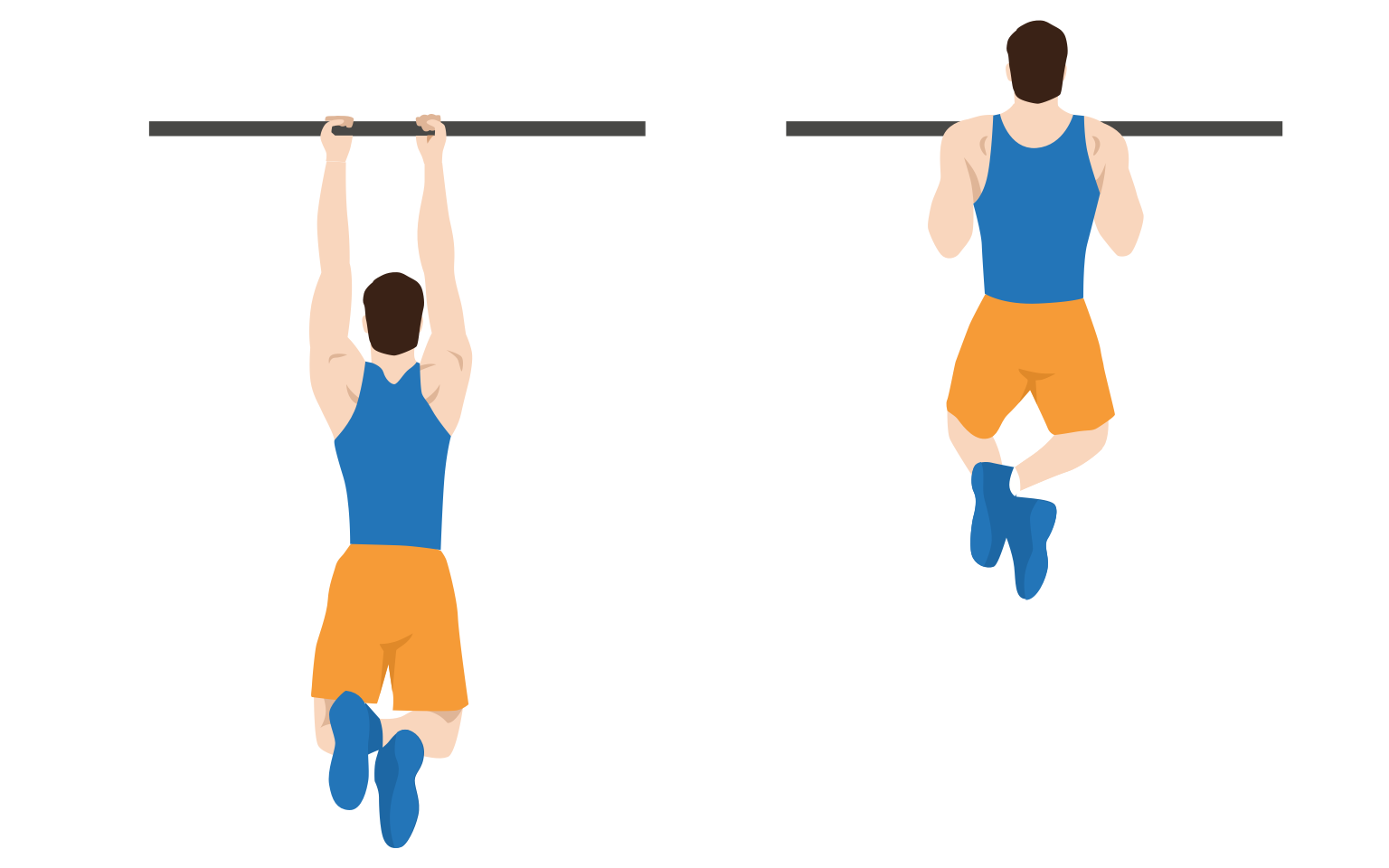
Chin ups are a compound, bodyweight exercise that are great for building upper body strength and endurance.
How to do
- Grab a pull up bar with an underhand grip (palms facing towards your body). Your hands should be shoulder-width apart.
- Pull up until your chin is just above the bar, using a smooth and controlled motion.
- Then lower back to the starting position.
Read more: How to Do Chin-ups

Inverted rows are more accessible than chin ups, because your feet remain on the ground throughout the exercise. This means you are lifting less bodyweight. Inverted rows target your mid-back muscles, as well as your biceps and lats.
How to do
- Set a barbell in a rack at waist height. Lie below the bar facing upwards.
- Grab the bar with an overhand grip, with your hands about shoulder-width apart on the bar.
- Pull your chest up to the bar, squeezing your shoulder blades.
- Then lower back to the starting position.
Read more: How to Do Inverted Rows
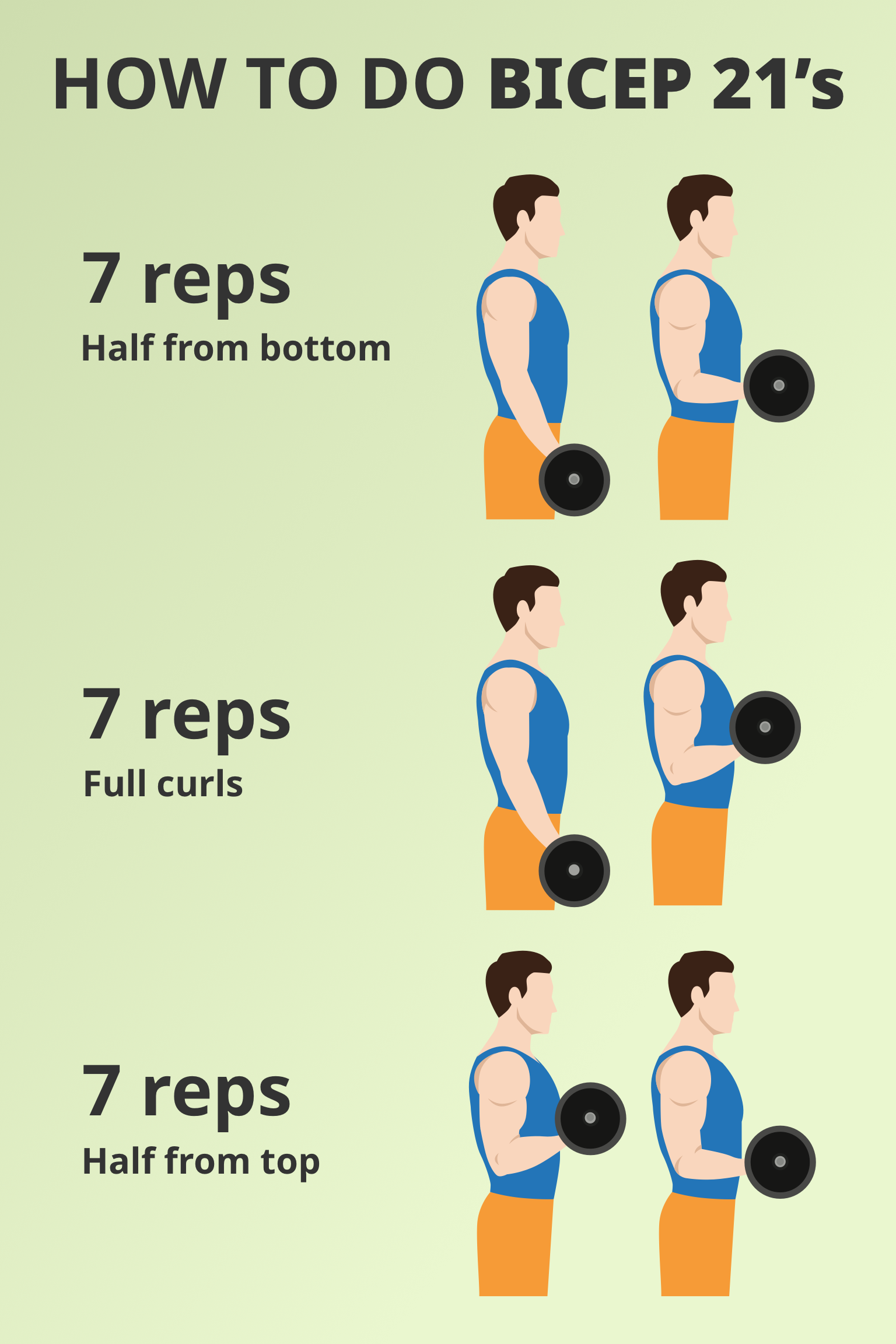
Bicep 21's is an exercise of three parts, each part working your biceps slightly differently. This variation is one of the more intense bicep workouts because it maintains a prolonged tension.
How to do
- Hold a barbell with an underhand grip, with your hands shoulder-width apart.
- Do 7 half lifts from the bottom of the movement.
- Next, do 7 full curls.
- Finally, do 7 half lifts from the top of the movement. Keep your elbows close to your body throughout the exercise.
Bicep workouts and challenges
Here are our favorite bicep workouts and challenges:
Bicep workouts top tips
- In your workout routine, work larger muscles first. Start with compound exercises like pull-ups and rows, then target smaller muscle groups with your bicep workouts.
- If you have a muscular imbalance, include simple isolation exercises like bicep curls in your bicep workouts.
Whether you are a beginner or an experienced gym-goer, there's a bicep exercise here for everyone - whether that's a standard dumbbell bicep curl, TRX curls or even Bicep 21's.
A variety of exercises is key to robustly building bigger and stronger muscles. Each variation here hits your biceps in a different way. Our collection includes hammer curls, preacher curls, cable machine curls, barbell curls and compound bicep exercises. Learn the benefits of each exercise to add to your bicep workouts.
References
Anderson, C. E., Sforzo, G. A., & Sigg, J. A. (2008). The effects of combining elastic and free weight resistance on strength and power in athletes.
Changelog
- 18 October 2023 - Bicep curls and exercises guide first published by Jane Litfin, with over 30 bicep exercises.
- 9 January 2025 - Substantial content update and layout change by Jane Litfin. Adopted a more user-friendly content layout, by including all bicep exercises at the top of the page. Separated the 34 curls and exercises into distinct categories to make the page easier to navigate. Only the first exercise in each category is shown by default, with the remaining variations hidden by expandable sections.
